PinotFile: 12.1 December 16, 2019
|
A Tribute to Burt Williams & Morning Dew Ranch
since its creation, Williams Selyem has been the mothership of Sonoma Pinot Noir.” Jan McInerney, Wall Street Journal
As I was composing this tribute, Burt had passed away at the age of 79 years on December 12, 2019. It was with a heavy heart that I completed this tribute that also became a eulogy.
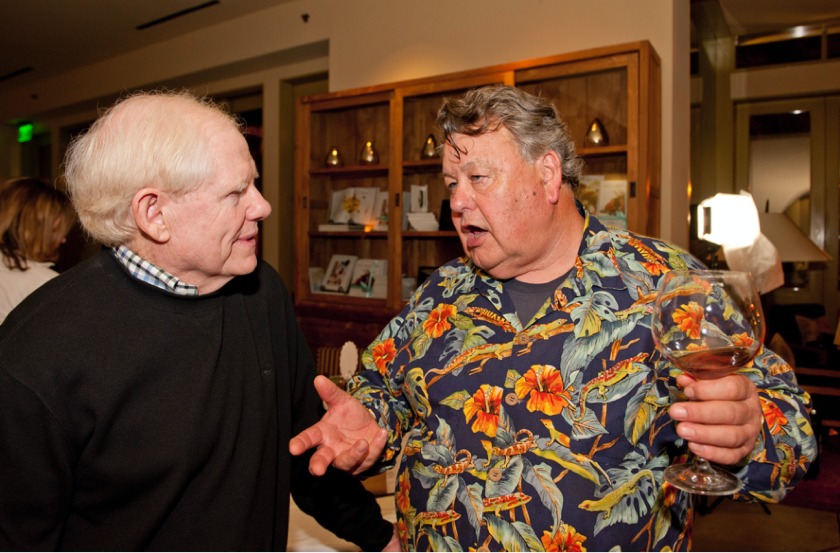
A San Francisco Native Finds His Wine Muse in the Russian River Valley
After graduation, Burt did not have enough money to attend college, so he began an apprenticeship as a printer for the San Francisco News Agency. He had an uncle in the printing industry and because Burt was always competent in English, he had no problem passing tests to become a printer. Besides, he found that the job paid pretty well. Burt met Jan on the River as a teen and she would become his wife in 1959. Their marriage lasted 48 years until Jan’s passing in 2011. Together, they raised two daughters, Margi and Katie. and a son Fred. All would become integral to the winery in Burt’s future. Jan and Margi are shown in the photo below at the 2007 Anderson Valley Pinot Noir Festival.
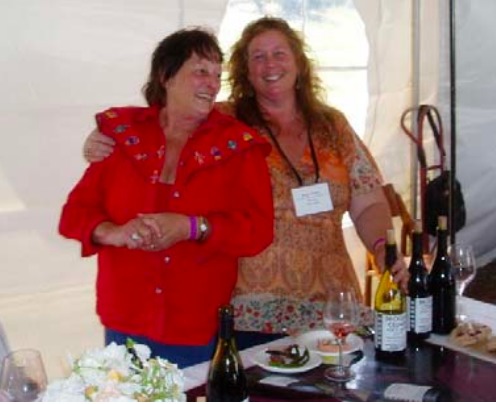 In 1962, Burt bought a house in Forestville that he owns to this day and the next year moved to that house in the Russian River Valley. His uncle had interested him in wine as Burt got older and Burt made his first purchase of a case of wine at age 20 at Pedroncelli Winery in Geyserville (they didn’t ask for an ID back then). He drank a lot of Zinfandel from the Russian River Valley and in 1964 made his first homemade wine, a Zinfandel, using grapes donated by a neighbor who could not find a buyer for his fruit. Burt wouldn’t start making wine again until the 1970s but his love for wine never wavered. He remembers being particularly intrigued by Hospice de Beaune Burgundies that a friend shared with him. He has said, “I started drinking Pinot Noir when I could get my hands on good Pinot Noir and dabbled in Burgundies until they got way too expensive to purchase.” His foremost reason for starting his own winery was, “I wanted to make some good Pinot Noir to drink so I wouldn’t have to buy expensive Burgundies.” During his summer vacations in the Russian River Valley as a youngster and later in his formative years, Burt developed a group of local friends. Two of his best friends were Brad and Ronnie Nichols. Their younger sister, Gayle, was to marry Ed Selyem, a fortuitous event that led to Burt and Ed’s friendship and winery partnership. Burt and Ed lived just across the Russian River from each other. Ed was a wine buyer and accountant at Speer’s Market in the Russian River Valley and had crafted beer and fruit wines at his home in Forestville, but his interest was in developing a successful business plan from local agriculture. By the time Burt and Ed began their collaboration in 1979, Burt had learned how to make wine. While on lengthy bus trips back and forth to work in San Francisco from Forestville, he read every book he could get his hands on, especially writings about old-fashioned methods of making wine in the Burgundian tradition. He mined the practical advice of both older and younger Russian River Valley winemakers who offered encouragement. Burt attended Burgundy tastings in San Francisco and recalls going to an annual DRC tasting put on by Liquor Barn where he paid $17 for a one-ounce pour of each wine. He also found winemaking courses from UC Davis helpful. Blessed with a good palate and eventually possessing a keen understanding of the way Pinot Noir should be crafted, Burt figured out how he could make “a pretty decent wine.” During the1970s, Burt found it challenging to find a consistently good domestic Pinot Noir “I surmised that they were doing it right by accident one time. I only found an occasional super wine, with few repeaters. They didn’t seem to have good grape sources. To do it year in and year out consistently, I could produce something really unique that nobody else had done to date.” He sensed that there was a for world-class Pinot Noir in California. With no scheme, and a startup fund of $5,000 each, Burt, at age 41, and Ed who was five years younger, launched Hacienda Del Rio winery in 1979, named after the location of Burt’s house in the “Haciendas Del Rio” (or simply Hacienda) area of Forestville, a patchwork of homes and summer cabins. The pair’s first wines were made adjacent to Burt's house and the barrels put into the basement. Burt would recall, “I had no big plan. I wanted to buy grapes and turn them into good wine. We weren’t trying to conquer the world or make millions of dollars. We were trying to make the best wine we could and enjoy it ourselves. If enough was left over, we could sell it. We never imagined that we would become a cult winery capable of selling everything we made.” The partners realized that there were not a lot of Burgundy drinkers among wine lovers but there were some and they thought they might be able to appeal to them. In other words, create a niche for world-class California Pinot Noir among Pinot Noir consumers. In 1979, Burt and Ed crafted their first wine together at Burt’s home in Forestville. The wine was a Zinfandel since Burt had easy access to Zinfandel from Martinelli, Pedroncelli and others and drank quite a bit of Zinfandel leading up to 1979. Zinfandel was not in big demand, selling for only $400- $500 per ton at the time. The first Hacienda Del Rio Zinfandel was labeled “Sonoma County Hillside Vines” (photo below of this wine and two other historic bottles of the first two Pinot Noirs from the 1980 and 1981 vintages).
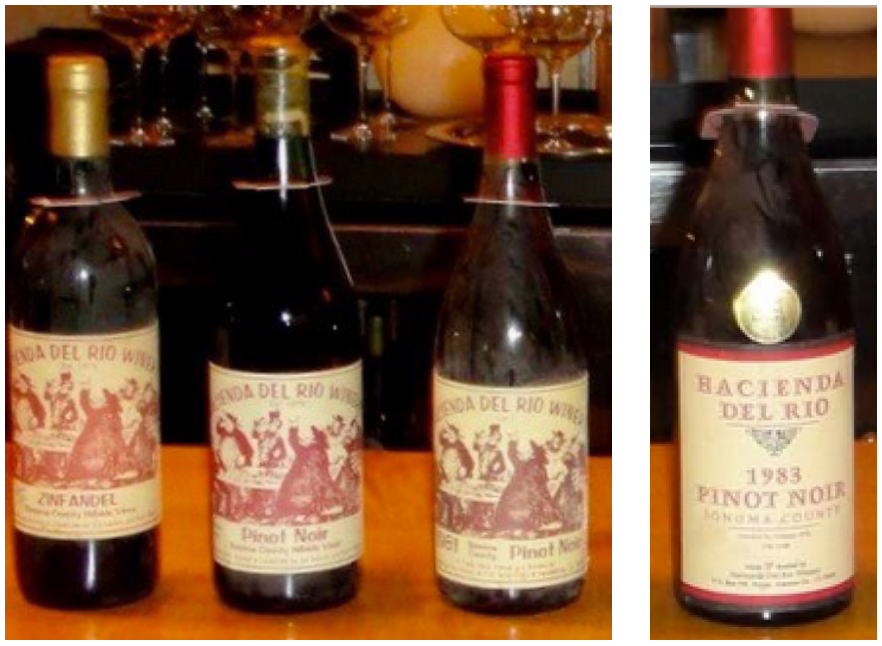 The 1979 and 1980 wines produced in Forestville were not commercially legal but a few bottles were sold and got out to other wineries. When a government agent spied some early Hacienda Del Rio bottles on a winery visit, he advised the partners to become bonded and they did in 1981 under the Hacienda Del Rio winery bond. The 1981 through 1983 vintages of Hacienda Del Rio wines were made at Russian River Vineyards, a winery in Forestville. The Hacienda Del Rio label features a sketch by the second illustrator, Hablot Knight Brown, commissioned for Charles Dickens’ first novel, The Pickwick Papers. The title of the illustration is “Mr. Weller and his friends drinking to Mr Pell.” A later version of the Hacienda Del Rio label looked similar to the current Williams Selyem label, using the same letterpress letters, color and paper (photo above). 1980 marked the year Burt first sourced Pinot Noir grapes from Joe Rochioli and were included in the first Pinot Noir bottled that year under the Hacienda Del Rio label as Sonoma County Hillside Vines Pinot Noir. Burt has said the Rochioli grapes were priced at either $550 or $600 per ton at the time as growers struggled to sell their Pinot Noir grapes profitably, yet as Burt noted, “These were really good grapes.” From 1980 to 1984 Rochioli Vineyard Pinot Noir grapes from Joe Rochioli's 1969 West Block plantings were blended with other Russian River Valley vineyard sources in a Sonoma County bottling. Rochioli Vineyard appeared first as a vineyard-designated bottling in 1985 under the Williams Selyem label as “Rochioli Vineyard Russian River Valley Pinot Noir.” Burt and Ed were not the first to produce a Rochioli-branded Pinot Noir as that honor goes to Davis Bynum in 1973. Still, 1980 will be remembered as the beginning of a seventeen-year handshake arrangement with Joe Rochioli whose grapes from the coveted West Block plantings at Rochioli Vineyard would become Burt’s most superlative Pinot Noir. Rochioli Vineyards & Winery kept a good part of the fruit for Rochioli’s own West Block bottling, and it would have made financial sense for the Rochiolis to keep all the West Block fruit for themselves. But Joe’s handshake commitment and friendship with Burt took precedent and this led to a string of benchmark Pinot Noirs that insured the success of Williams Selyem. That first commercial vintage under the Hacienda Del Rio label came in 1981 and besides a Sonoma County Pinot Noir, included 343 cases total of Dutton Ranch Pinot Noir, Iron Horse Vineyards Pinot Noir and Martinelli Vineyard Zinfandel. Burt sourced Pinot Noir from Iron Horse for the 1981 and 1982 vintages. I am not sure of the Dutton vineyard source in 1981 but Arrendell Vineyard farmed by the Duttons was a source of Pinot Noir from 1982 to 1986. A flyer announcing the release of three 1981 wines stated, “Our goal, as a winery, is to bring to the consumer wines that are representative of the cool region vineyards located in the Russian River watershed of Sonoma County. To accomplish this, we utilize traditional winemaking techniques, crushing and stemming into small open tanks, allowing fermentation to start when possible on the grapes’ own microflora, punch down the cap by hand, and gravity siphoning or pushing with inert gas when racking. Our wines are aged in 60-gallon or smaller oak barrels and bottled without fining or filtration unless absolutely necessary. We back these traditional practices with modern scientific analysis to insure you of a sound wine.” A copy of that flyer is reproduced below and interestingly, included TA and pH along with ABV for each wine reflecting Burt’s focus on wine chemistry.
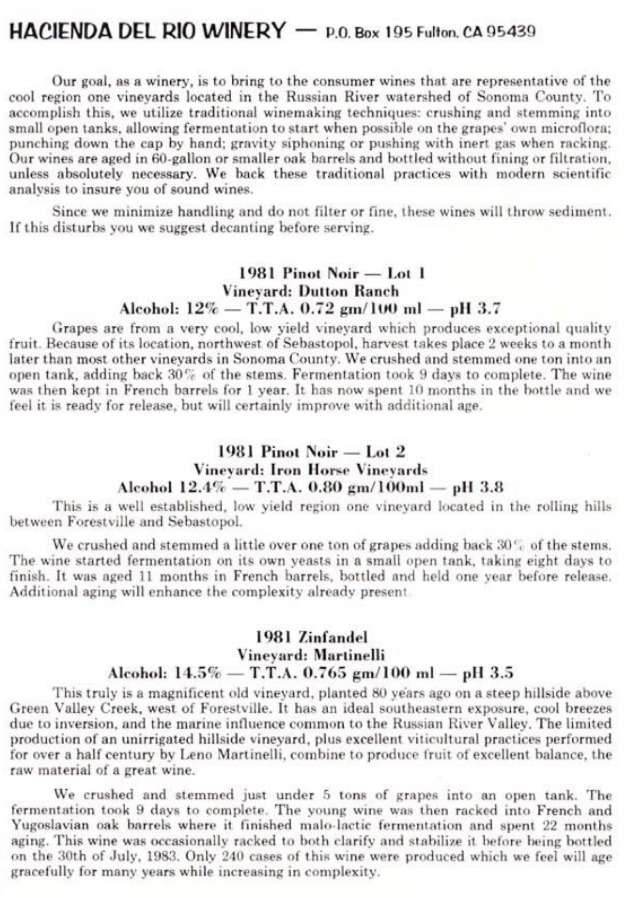 Burt crafted 240 to 300 cases of Zinfandel annually from Leno Martinelli’s “Jackass Hill” Vineyard from 1981 to 1992. Martinelli’s vineyard was located in Forestville and planted in 1899. A tiny amount of Muscat Canelli from grapes grown on the lower portion of Martinelli’s vineyard was also produced but little was sold to the mailing list members. A Chardonnay from Allen Vineyard was added to the lineup in 1992. However, the winery’s main focus through the years was Pinot Noir and Williams Selyem was one of the first wineries in the Russian River Valley to concentrate on Pinot Noir. Beginning with the 1984 vintage, the partners shifted to their surnames and the winery became Williams and Selyem Winery, later shortened to Williams Selyem. This was necessitated by a complaint from Hacienda Wine Cellars and a conflict with a Mexican restaurant in Guerneville named Hacienda Del Rio. A copy of the Wine Spectator 1986 report on the change in name of the winery is reproduced below.
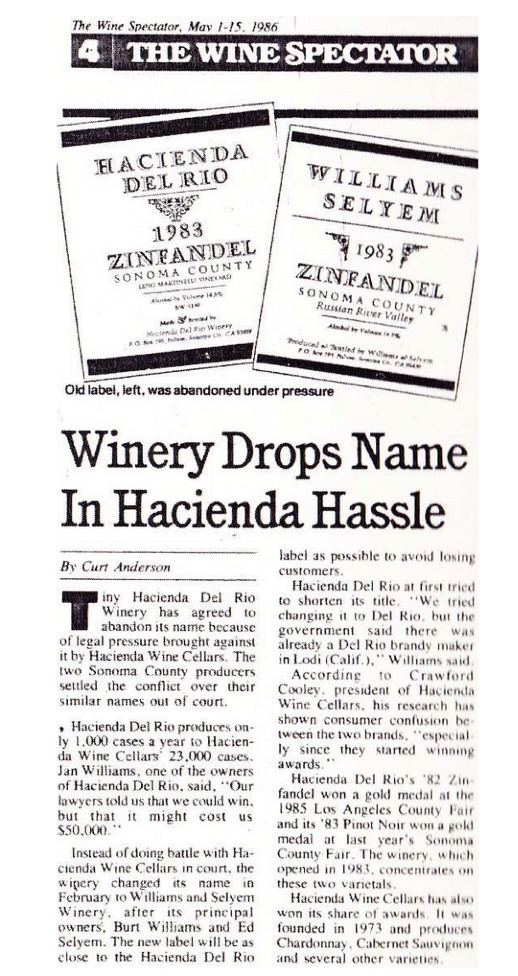 Burt, along with Burt’s friend, Graham McIntosh of San Francisco’s White Rabbit Press, designed the new Williams Selyem label. The simple black-and-red label had a background of cream-colored paper adorned with a stock ornament known to typesetters as a dingbat. This logo was never changed and the label remains unchanged to this day.
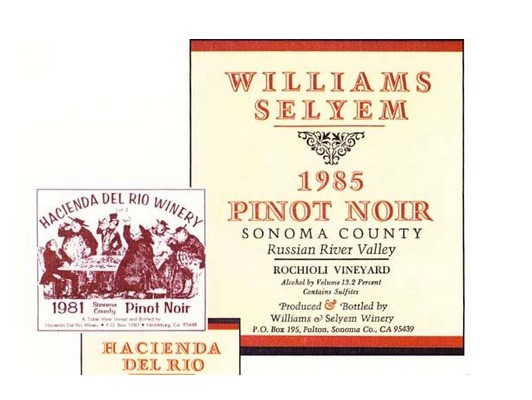 1984 was also the year that production was moved to a leased 900-square-foot, two-car garage adapted for winemaking on River Road in the tiny Russian River Valley town of Fulton. Williams Selyem had officially become the first California “garagiste” Pinot Noir producer. Many others were to follow but what distinguished Williams Selyem is that their winery really was in a garage while others most often worked out of larger warehouse-type facilities. The photo below shows the original garage as it looked in 2009. The following photo shows Ed on the pad outside the garage where fermentations were carried out in repurposed dairy tanks.
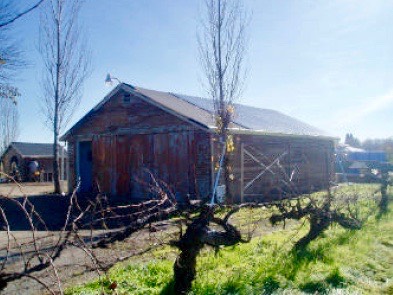
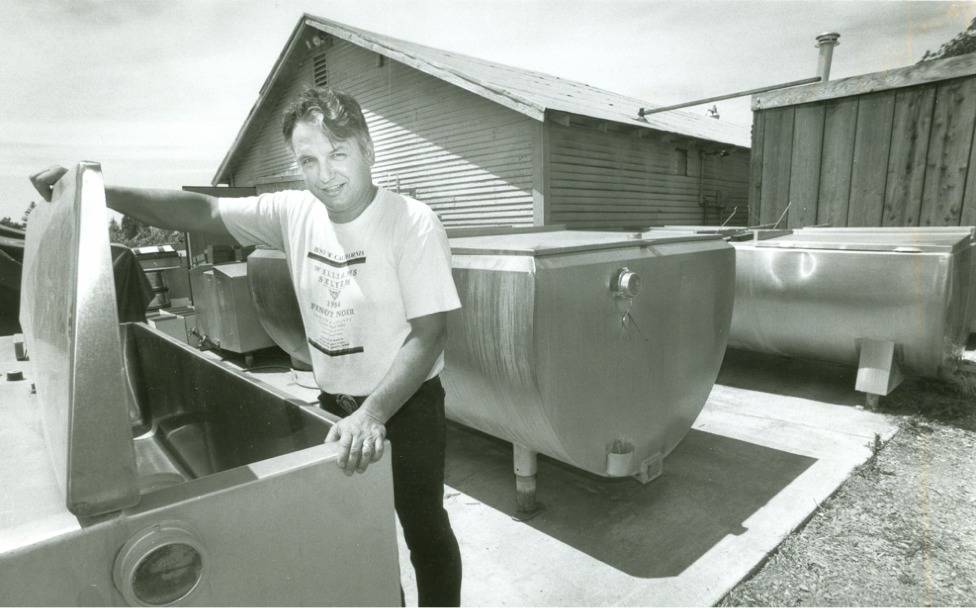
Necessity was the Mother of Invention
James Laube, Wine Spectator
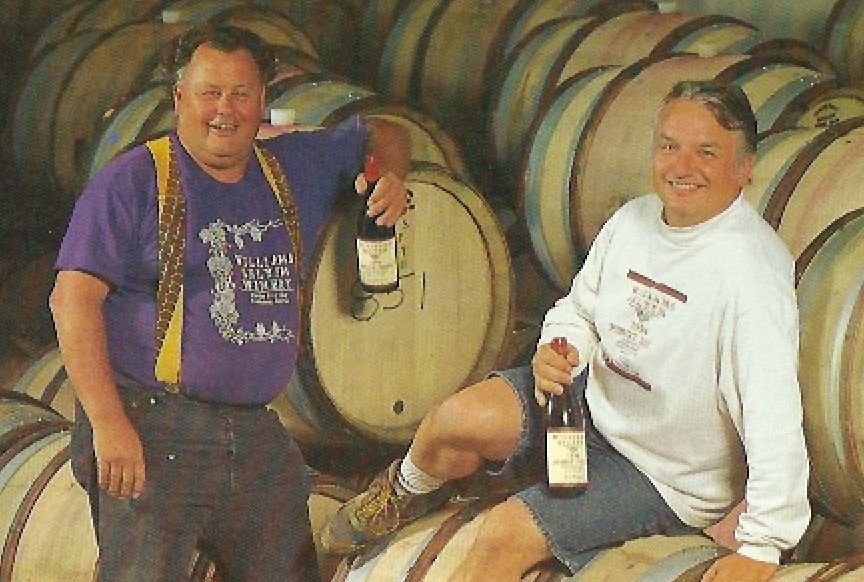 Burt and Ed formed an ideal partnership. Burt directed the winemaking and Ed managed the money as well as marketing, sales and distribution of the wine. The pair continued their day jobs and raised their families, taking vacations at crush time to make the wines. They never took any money out initially, grew at a 25% rate per year, and kept putting all profits back into the winery for the following year’s grapes and winemaking’s bare necessities. They hired no outside help early on and relied upon volunteers and spouses for assistance. The old Italian winemakers in the Russian River Valley had advised Burt not to buy anything new. They told him to borrow what he could and if necessary buy only used equipment. The fledging winery had little money so Burt relied on that advice. He used traditional hands-on ways of winemaking with primitive equipment out of necessity but soon realized this was the best way to craft Pinot Noir. This approach meant more labor, but the work was rewarding. It was basic winemaking at its simplest using no mechanization, pumps or filters. The winery’s first sorting tray was built from a sheet of plywood covered with plastic. De-stemming was carried out in the early years using a basic de-stemmer borrowed from Lytton Springs Winery. the de-stemmer was eventually bought it 1984 ( a new one did not arrive until 1991 which further improved the quality of the wines). A family friend loaned the winery a hand-crank press that dated to the early 1900s that was put into use after some refurbishing. The press had not been used in 40 years when Williams Selyem acquired it. A new press would not be in the winery budget until 1989. The use of repurposed dairy tanks was both inexpensive and practical. Burt had seen a few other wineries use dairy tanks for fermentation such as Hop Kiln in Healdsburg and Edmeades in the Anderson Valley. The dairy industry in the early 1980s no longer stored milk. Tankers were filled as they came to the dairy making storage tanks obsolete. Dairy storage tanks were available for as little as 25¢ to 1.25¢ a gallon. Some could be found languishing in barns or fields. The double-walled tanks were made of better stainless steel than tanks in use by wineries at that time. Burt’s son-in-law was a welder and he removed the lids, agitators and extraneous metal and re-plumbed them for cooling. The advantage of the dairy tanks for fermentation was the width, length and shallow depth of the tanks that conferred a better cap to juice ratio leading to better extraction of color and fruit compared to the traditional six-foot-high fermenters in use at the time. The photo today shows one of the original recycled dairy tanks at Williams Selyem Winery in 2012.
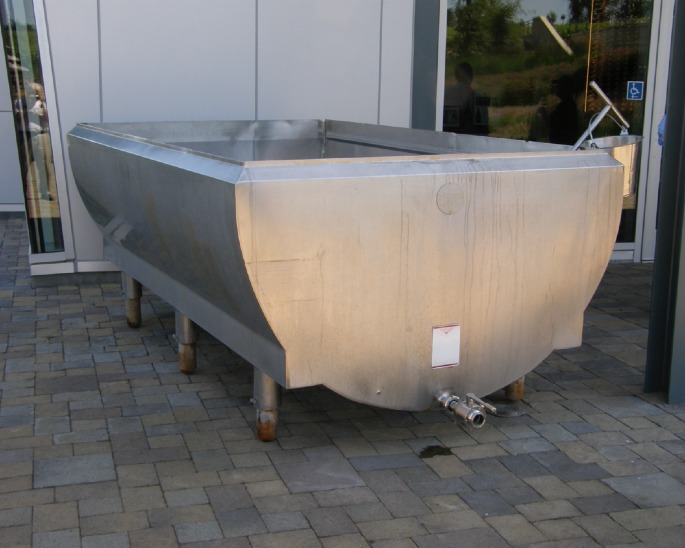 There was one particular “angel” who proved critical early on. Burt recalls that in 1982, Marvin Schaeffer, a winery customer, came to the winery and tasted some of the Williams Selyem Pinot Noirs. He said, “These wines are fantastic. What would make the wines even better?” Burt told him he could make the wines even better if he had some new French oak barrels that were costing $350- $400 at the time. Schaeffer wrote out a check on the spot for 10 to 12 new barrels, handed it to Burt, and said, “Use it, I don’t need it.” It wasn’t until 1994 that Schaeffer would accept repayment. Burt remembers the encounter with a sigh, “Magic things happen once in a while.” 40-pound lug boxes were initially used to hold picked grapes at harvest. They were weighed and loaded onto a 350,000-mile Chevrolet pickup parked at the end of the rows and taken to the winery (photo below). Quarter-ton wooden bins were subsequently used when Williams’ son-in-law designed and built a unit to transfer the grapes to the sorting table.
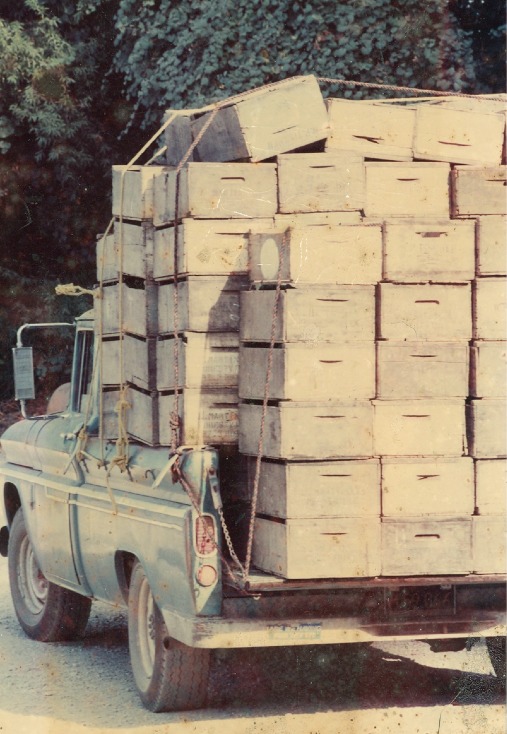 Another primitive but practical part of the winemaking regimen at the Fulton garage winery was carrying out additional barrel storage in cargo shipping containers that once contained New Zealand lamb carcasses. ߐ
Notoriety Snowballed
That was when I knew we were doing something right.” Burt Williams
Awards for Burt’s Pinot Noirs began to accumulate beginning with the 1982 vintage. Burt and Ed believed they needed to gain exposure by entering various regional and state wine competitions. The 1982 Sonoma County Pinot Noir won a Gold Medal at both the Orange County and San Francisco Fairs and earned First Place in the American Wine Pinot Noir Championships. The 1983 Sonoma County Pinot Noir won a Gold Medal at the Sonoma County Harvest Fair. The 1984 Sonoma County Pinot Noir won a Double Gold Medal and Best California Pinot Noir at the California State Fair and Gold Medals at both the San Francisco and Los Angeles Fairs. The 1985 Sonoma County Pinot Noir was selected and served at the White House to President Reagan and Prime Minister Mulroney along with guests and also was served to President Bush and the President of the Republic of Costa Rica. In 1986 Burt was invited and attended the Wine Spectator New York Wine Experience as part of a “Top New Winemakers of the Year” seminar. Burt remembers that George Bursick, Tony Soter, Randy Dunn and Randall Grahm were also honored winemakers. The notoriety of Williams Selyem Pinot Noir really began to snowball in 1987. The 1985 Williams Selyem Rochioli Vineyard Russian River Valley Pinot Noir, the first vineyard-designated Pinot Noir produced at Williams Selyem, won a Double Gold Medal and the Sweepstakes award at the California State Fair Competition, becoming the most seminal wine in the history of California Pinot Noir. The wine was voted the best of 2,316 wines entered by 416 wineries. Priced at $16 a bottle, a total of 295 cases were produced. Williams Selyem was also given the distinction of "Winery of the Year.” When Burt reminisces, he nearly tears-up, saying, “Here was this little winery in a garage competing against over 400 wineries in the wine competition, many of which were quite large.” An article appeared in the June 27, 1987, business section of the Santa Rosa Press Democrat announcing the top prize won by Williams Selyem and is copied here below. Note the incorrect name of the winery in the article. The early winery mailers written by Ed and sent to consumers referred to the name of the winery as Williams & Selyem Winery later shortened to Williams Selyem, but the two names were never hyphenated.
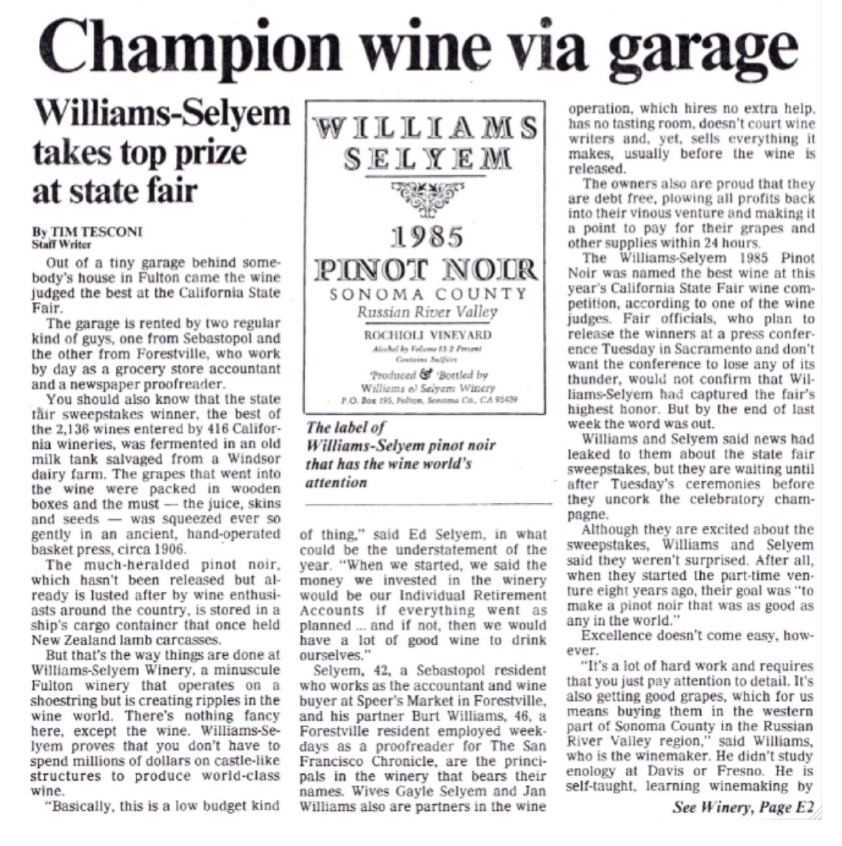
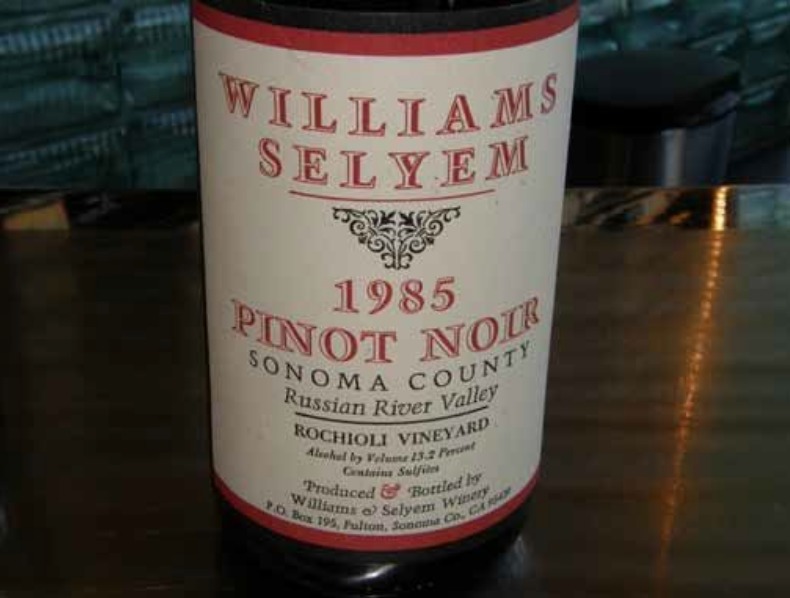 After the Sweepstakes award, Williams Selyem was showered by accolades from the press and many people, including winemakers and winery owners, flocked to obtain the small production wines. Burt would say, “It put us on the map.” Wine writer Dan Berger said, “Best Pinot Noir in America and a rival to the best in the world.” Respected wine writer Matt Kramer declared, “Williams Selyem is the best Pinot Noir in California. A Pinot Noir of delicacy, finesse and profound flavor.” Anthony Dias Blue, a leading international wine authority chimed in, “Williams Selyem Pinot Noir shines above the rest.” The Wine Spectator’s California wine editor, James Laube, said, “Winemaker Williams has a tremendously intuitive sense of how Pinot Noir should be vinified and how it should taste.” In 1987, Becky Wasserman visited the winery along with her spouse Russell Hone and Burgundy vigneron Michele LaFarge, and the trio tasted through the 1985 and 1986 Rochioli Vineyard Pinot Noirs. The importance of this connection cannot be overemphasized. Becky Wasserman & Co. was founded in 1979 by Becky Wasserman-Hone, an American expatriate who began living in Burgundy in 1968. She was a highly-respected exporter of wines from small domains and shippers in Burgundy and other regions. After the tasting, she wanted 50 cases of the 1985 and 1986 Rochioli Vineyard Pinot Noirs to export to Burgundy. Burt could only give her 1 case of the 1985 vintage (most of it was pre-sold or spoken for) and 25 cases of the 1986 vintage. Reminiscing, Burt recalls, “Unbelievable - wow! We had to pinch ourselves. The wine was actually placed on restaurant lists in Burgundy. That’s kind of neat.” Burt soon decided to place his wines in the best restaurants and resorts on the Monterey Peninsula, knowing that affluent people visited that area from all over the United States. This was extremely beneficial insight for diners were soon calling Williams Selyem from all over the United States, asking for wine. Americans had never tasted Pinot Noir like Williams Selyem and they pleaded for their allotment. Burt and Ed believed in building their winery through personal connections. They often delivered their wines to restaurants and retailers because they enjoyed meeting the staffs. Paul Root, who owned a retail wine store, Root’s Cellar, located in Healdsburg (now closed), told me of this story. Each spring Burt and/or Ed would arrive at his store’s back door with a truckload of wine. They would off-load it all into the storeroom and leave an invoice on the desk with a hand-written note that said, “Pay us when it’s sold.” The winery had quickly and unexpectedly achieved cult status, and because of the deluge of people trying to obtain the Williams Selyem wines, Ed came up with the idea of a mailing list to fairly allocate the wines. He knew that the best chance for the winery’s financial security was to sell most of the wine directly to consumers at retail prices. The mailing list also turned out to establish a very personal connection between Burt and Ed and their customers as mailing list members received a mailer with each new release period containing colorful, folksy commentary by Ed as well as tasting notes from both Burt and Ed. Soon, 85% of production was sold to consumers through the mailing list. with 15% held back for the owner-partners and retail and restaurant distribution. I was fortunate to be a member of the mailing list beginning in 1989. It wasn’t long before the mailing list was full and a waiting list created to handle the overflow. There was simply not enough wine to meet the demand. Tog give you an idea of how hard it was to obtain the wines George Levkoff tells the story of the first time he visited the winery on Westside Road, Margi met him and told him he couldn't buy any wine but she could sell him some swag like a Williams Selyem tee shirt! By 1998, the mailing list and waiting list contained at least 35,000 names! Several staff members were necessary just to manage the lists. Even though Burt and Ed initially only hoped for modest earnings to fund their retirement, Williams Selyem rather quickly received widespread renown and adoration and welcomed the profitability that went along with that popularity.
Moving Up to the Westside
Burt Williams
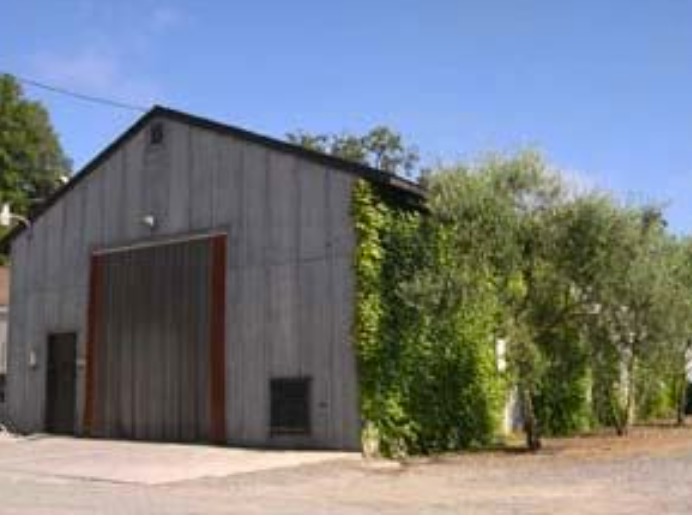 Williams Selyem moved to the new facility in December 1989. The winery was a nondescript warehouse-style structure with winery equipment stationed outside in the back on a concrete pad covered with a tin roof. There was no signage on Westside Road and only a small sign on the building indicating it was the home of a very renown cult winery. Public tastings at the winery were not accepted for several years. After the move in 1989, the winery became self-supporting within another three years and Burt and Ed quit their regular jobs. When they began, the partners never anticipated that their wines would develop a cult following and financial success would allow them to leave behind their day jobs.
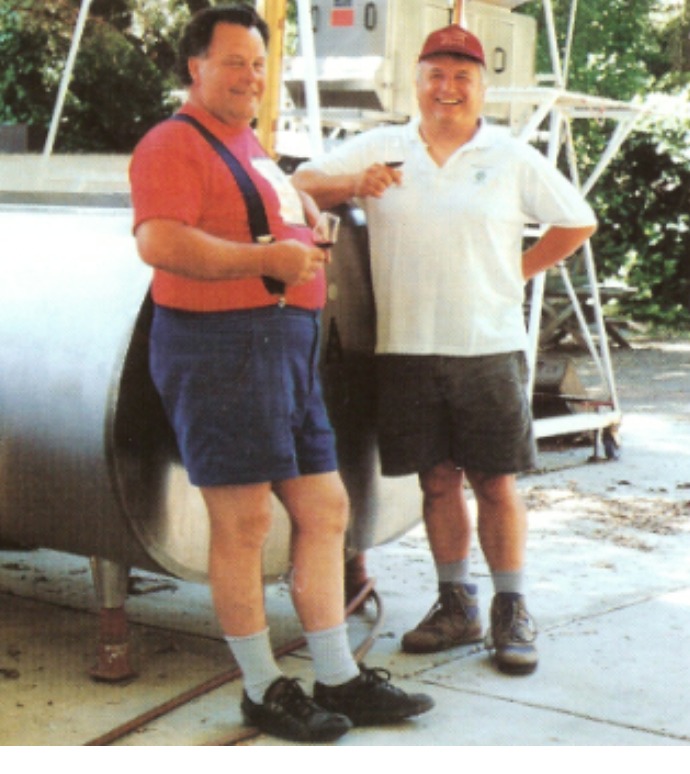
Methodical and Intuitive Winemaking
Thomas Rivers Brown, winemaker
Picking decisions were driven by both Brix and pH. Burt wanted substantial enough acidity to allow his wines to age without any or minimal acid additions. A hydrometer was used to test titratable acidity (TA) and pH. Generally, grapes ideally were picked at 23.5º to 24.0º Brix. That said, Burt always emphasized that Brix was not as important as the fruit showing ripeness all the way to center of the grape surrounding the seeds. Burt’s close relationship with growers allowed picking of grapes quickly when Burt and Ed found harvest to be at an optimum stage Burt realized that his customers did not relish tannic wines so he chose to primarily de-stem grape clusters prior to fermentation. He did use some percentage of whole clusters in the bottom of the fermentation tanks if the stems were ripe but avoided green stems. In 1993, for example, the vintage was very cool followed by a heat spike in August. The grapes achieved ripeness but the stems were green so he de-stemmed everything in that vintage. The percentage of whole clusters varied. He found some clones such as Mt. Eden were more tannic. If he used stems the wine became even more tannic so he avoided whole clusters completely with that clone. Burt used up to 33% whole cluster often and even 50% for the Pommard clone from Rochioli Vineyard. In the early years, Burt employed wild fermentation. But in 1984 the United States government began offering rebates on advances to further the wine industry. Burt always wanted to have his own yeast isolate so he pursued the development of his own yeast isolate that would produce reliable fermentations. He knew the yeast from the Leno Martinelli Vineyard was strong because Zinfandels from that vineyard finished fermentation completely with Brix up to 18.5º. Burt considered it important to have a yeast that would take a wine all the way to dryness and thereby avoid filtration. Once the yeast was isolated, Burt used it on all Pinot Noir fermentations. He would wait for 3 to 4 days before adding the Martinelli isolate and let the yeast gradually take over the fermentation. This always worked and Burt never had a secondary ferment in the bottle. Burt chose a 3 to 4-day pre-fermentation maceration (cold soak). Ice and sulfur dioxide were added to prevent fermentation during the cold soak. He then preferred a slow fermentation if could it was controllable. When the must reached about 12º Brix, he would allow fermentation to take off, shooting for an 88ºF to 90ºF peak temperature. He added malolactic bacteria when the ferment was hot so when he siphoned off the wine to barrel in 1 to 2 days, it was in the juice and allowed malolactic fermentation to take place. In summary, Burt would start off cool, warm up the must in the middle with the peak temperature near the end, finally dropping the temperature back down and barrel when the juice was still warm in the 70ºF to 80ºF range. It was routine for Burt to meticulously check temperatures three times a day and document his findings in writing which proved invaluable to him as a reference over the years. When Burt had installed temperature control of his fermenting tanks, his fermentations proceeded in a manner that he preferred most of the time. Although Burt had a preferred fermentation regimen, he considered other options as necessary driven by his intuition. He would modify his approach depending on many factors including the vineyard source, vintage and state of the grapes when they arrived at the winery. As an example, one vintage he received grapes from Summa Vineyard that had considerable rot fuzz on them. He chose to ferment fast and hot to get fermentation over with. The resulting wine turned out very decent. There was little juice the first few days of fermentation so Burt and Ed would don waders, get into the tank and tread on the grapes to free up some juice. Hand punch-downs were initiated later on. There was no grape crushing per se. After the free-run juice was sent to barrel, the residual must and juice were bucketed into the press, gently pressed and in some cases, topped off the free-run juice. Pumping was avoided entirely and racking of the wines used gravity or assisted gravity with gas. Malolactic fermentations in barrel were usually finished in January or February following the vintage year. The wines were racked off the gross lees in March of the following year and separated into blends or vineyard designates. The appellation wines were aged typically 11 months and the vineyard-designated wines usually 17 months. The wines were usually unfined and never filtered. Sulfur was kept to a minimum as Burt was allergic to sulfur. The bottled wines were then aged further before release. Blocks from the same vineyard were often kept separate and some went into a vineyard designate bottling and some into a Russian River Valley, Sonoma Coast, Sonoma County or Mendocino County blend. When it came to barrel selection, Burt had read a number of French texts that he had translated. He found a major French study from the 1970s that looked at the barrels being used in Burgundy over a three-year period. The best barrels for Pinot Noir turned out to be from the forest of Tronçais in the Allier department of central France. Based on this study, he chose to use barrels from this region and specifically ones favored by Domaine de la Romanée-Conti produced by Francois Frères. He simply sent Francois Fréres some of his wines and asked for the “toast of the house.”
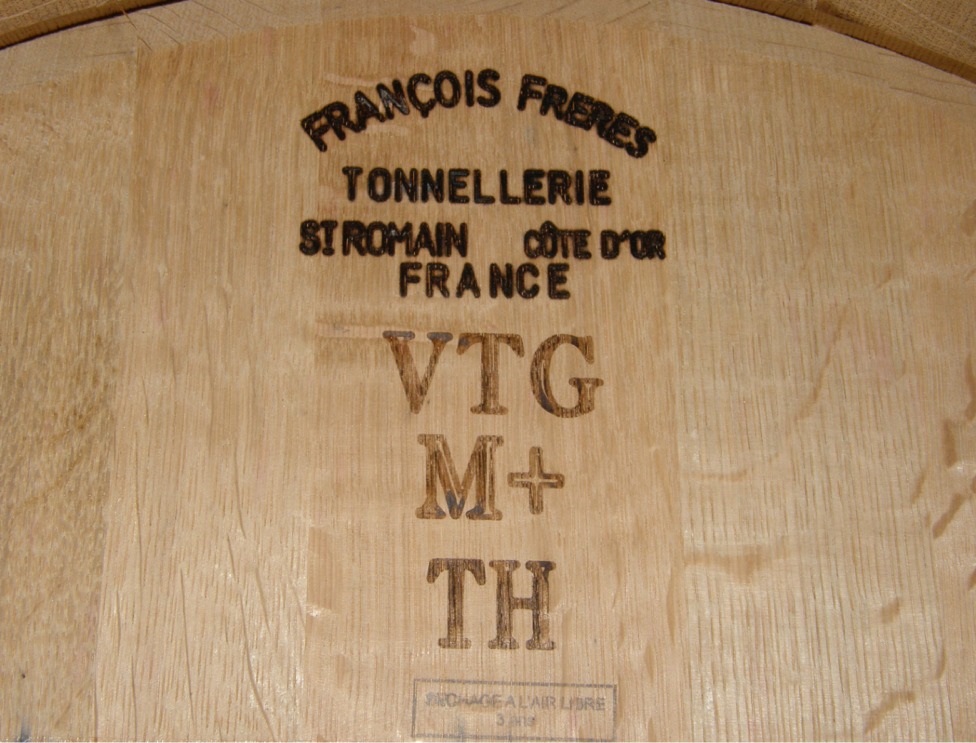 The percentage of new oak varied between 50% and 100%. For Rochioli Vineyard, Burt had used 50% new oak until 1984 but found the wines “too fruity.” In 1984, he used 100% new oak and the wine lost its overt fruitiness. Burt never wanted fruit bombs but instead wanted each wine to show its fruit character and the place it came from. He would say, “I wanted the wines to taste like wine.” Barrels for the vineyard designates were never used more than twice. Before release, the wines were hand-bottled, labeled and foiled. Burt and Ed held back a good amount of their production for their own consumption, including magnums. Magnums were produced in significant numbers, a highly unusual practice for California wineries at the time. In general, Burt would recommend that his Pinot Noirs be ideally consumed six years after the vintage. Burt summarized his winemaking in a 2003 interview in the Wine Spectator. “It boils down to constant selection, from the vineyard to the barrels, and close observation of the fermentation process, gently guiding it along and hopefully eliminating potential problems before they occur. The rest lies in what I didn’t do: pump, fine, filter or over-sulfur.” Chris Whitcraft, a Santa Barbara County-based winemaker and close friend of Burt’s, best summarized his winemaking as follows: “I think the most impressive thing about Williams is he uses common sense with his wines.” The end product or “house style” of Williams Selyem Pinot Noir was described by Burt as follows. “Vanilla, sweet-like fruit with a voluptuous nose overshadowed by each vineyard’s different fruit that was most apparent when tasting the wines next to each other.” Burt also remarked, “Stylistically, one priority for my wines was transparency which is easy to say but a lot harder than one might think to do. It was just a matter of trying to let the fruit say whatever it had to say. I always had the philosophy that less was more which is a much easier approach when you are confident in the quality of your fruit.” In other words, he strived to retain the character of each vineyard so that the vineyard-designate bottlings stood on their own. Burt has said that the Russian River Valley Pinot Noirs prominently featured cola and spice, the Sonoma Coast Pinot Noirs Oriental spice and dried citrus peel, and the Anderson Valley Pinot Noirs more floridity. One of the most appealing features of Williams Selyem Pinot Noir was that the wines were exceptionally appealing upon release. Burt strove for balance in his wines so that they drank easily upon release yet would age beautifully. I know for a fact that the wines were gorgeous initially because I quickly drank up all of my allotments. When the subject of best vintages came up, Burt had a clear explanation. “Favorite vintage characterization many times comes from an initial release experience. Further aging of any of our wines I think mitigates the difference between ‘your favorite vintage’ and other vintages that you just enjoy on release. In the end, these vintages are all enjoyable but different ‘children’.” In the spring 1997 W&S News mailer, Burt did note that the opulent vintages on release came in 1981, 1983, 1984, 1985, 1987, 1989, 1991, 1993, and 1995. On another occasion, Burt cited the 1983 Jackass Hill Leno Martinelli Vineyard Zinfandel, 1986 Rochioli Vineyard Pinot Noir and the 1991 or 1995 Summa Vineyard Pinot Noir as among his favorites. He was often asked to name his most-liked wines but was usually quite reticent to name them. Vintage considerations were not especially significant for Burt’s Pinot Noirs as noted by Wine Spectator’s Jim Laube: “In difficult vintages, Williams Selyem Pinot Noirs usually rise to the occasion and surprise with their subtleties. In great years, they excite and inspire.”
Great Wine Only Comes from Great Grapes
there were plenty of good grapes since few were making Pinot Noir.” Burt Williams
As noted previously, Burt sourced Pinot Noir from Joe Rochioli’s West Block beginning in 1980. The widespread accolades for the 1985 Rochioli Vineyard Pinot Noir and Burt’s influence on Joe's son, Tom, led the Rochiolis to begin making their own Pinot Noir from the Rochioli vineyard. In 1987, Joe Rochioli introduced Burt to Howard Allen who owned a 32-acre vineyard dating to1972 that was located directly across Westside Road from Rochioli’s Vineyard and was farmed by Joe. Allen Vineyard became a single-vineyard bottling in the Williams Selyem lineup that same year. Howard Allen became well-acquainted with Burt as they walked Allen’s vineyard together many times. Howard would say, “It's the working together with the winemaker that creates great wine.” Allen Vineyard also was the source of the first Williams Selyem Chardonnay in 1992. Burt crafted 150 to 200 cases of Chardonnay annually from Allen Vineyard. The wines were barrel fermented, aged 11 months in 50% new and 50% used French oak barrels with once-weekly lees stirring. A long-term relationship was established with Bob Pelligrini who owned Olivet Lane Vineyard on West Olivet Road. Williams Selyem released the first Olivet Lane Vineyard Pinot Noir in 1987. Cohn Vineyard (1987), Hirsch Vineyard (1994), Coastlands Vineyard (1994) and Previous Mountain Vineyard (1996), all located in the far western reaches of the Sonoma Coast, and Ferrington Vineyard (1993) in the Anderson Valley also joined the winery’s portfolio. Rochioli Riverblock Vineyard, planted in 1987, was added to the Williams Selyem lineup as a vineyard-designated Pinot Noir in 1994. The Rochioli Riverblock was groomed to replace West Block fruit (the West Block was pulled out after the 1997 vintage due to phylloxera and virus infestation) and the grapes were used initially in 1988 in the Russian River Valley blend. Later, the grapes became the “Riverblock” vineyard designate, and finally the Rochioli Riverblock vineyard-designated Pinot Noir. Some grape sources came and went. Iron Horse Vineyard provided Pinot Noir in 1981 and 1982, Dutton’s Arrendell Vineyard was a source from 1982 to 1986 and both the Cohn Vineyard and Buena Tierra Vineyard were grape sources briefly. Some vineyards, such as Thieriot Vineyard (now B.A. Thieriot) located in the far reaches of West Sonoma County, were never deemed suitable. Across the street from Thieriot Vineyard was Summa Vineyard where Burt first sourced Pinot Noir grapes in 1988 for the first Williams Selyem Pinot Noir from the Sonoma Coast. Although the vineyard was buffeted by wind and consumed by fog, and often suffered poor fruit set and very low yields, Burt had tasted wines made from this site and was enamored by the potential. The exact clones that were first planted at Summa Vineyard around 1980 have been open to conjecture but Burt believed these old vines were a Swan selection. Burt bottled five vintages from this Summa Vineyard: 1988, 1991, 1993 (a combination of Summa Vineyard and Coastlands Vineyard was also produced in this vintage), 1995 and 1997. Joan and Scott Zeller, who owned the vineyard, demanded $1,000 per ton for their old vine grapes, an exceptionally lofty amount at the time. Burt took over farming of the vineyard but yields were challenging or simply not enough to make a commercial wine in some vintages. In 1991, only one ton of Pinot Noir was harvested from 2 acres producing two barrels. Yields were minuscule in 1989 and 1990 and no usable grapes were harvested. Because of the yearly farming costs, Burt charged $100 for the 1991 Summa Vineyard Sonoma Coast Pinot Noir, the first California Pinot Noir to sell for triple digits. Burt figured if people wouldn’t buy it, he and Ed would drink it. Williams said about the price, “C-note or c-none.” The 10 cases offered were snapped up in a day and the rest Burt and Ed kept for themselves. The 1995 vintage of Summa Vineyard Pinot Noir was priced at $125. Burt was infatuated with the 1995 Summa Vineyard Pinot Noir. The 1997 W&S fall mailer described the wine in glowing terms. “You need a dictionary for adjectives. I’ve tasted practically all of the best producers’ Grand Cru red Burgundies for vintages well over a decade including 85s and 90s. I’m sorry, without prejudice, there has been nothing close to this wine.”
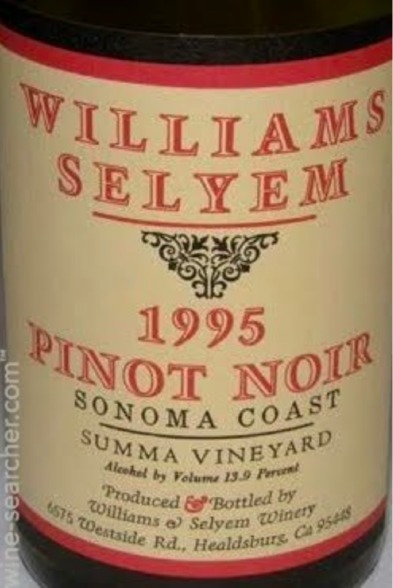 Although the vineyard-designated Williams Selyem Pinot Noirs were most desirable, the appellation wines, made from declassified lots of the vineyard designates, were also superb and aged surprisingly well. The Russian River Valley and Sonoma Coast appellation Pinot Noirs made under Burt's guidance were released first in 1988. The Russian River Valley Pinot Noir was offered again from 1990 through 1995 and the Sonoma Coast blend was offered from 1988 through 1990 and 1993 through 1995. A Sonoma County blend was made from 1981 through 1984 and again in 1994, 1996 and in 1997. Williams Selyem never owned any vineyards although, in 1987, Ed Selyem told the Santa Rosa Press Democrat, “Our goal is to purchase some agriculturally-zoned land in the lower Russian River Valley so that we can continue to produce this quality of Sonoma County wine on our own property.” This goal was never realized for several reasons. Both Burt and Ed were still working their regular jobs initially along with Burt making wine and Ed selling it. An estate vineyard would have meant another job. In addition, the partners felt they had access to the best vineyards that were already farmed by excellent growers. They were able to work with mature vines and the access to older fruit meant that their wines would potentially be rise above the competition in quality.
Worthy Tastings of William Selyem Pinot Noir
The Underground Wine Journal
For several years, Burt and Ed would meet annually with Win Wilson and Jack Daniels, importers of Domaine de la Romanèe (DRC) wines to sample each other’s wines. In 1992, Burt remembers a bacchanal over lunch when Win, Jack, Burt, Ed and winemaker Chris Whitcraft, consumed 23 bottles of wine that included Pinot Noirs from Williams Selyem and DRC and a Champagne at the start and finish. Burt would say, “We learned a lot but reached no conclusion about which wines were better. Nothing sweeter than a Pinot Noir hangover!”
Bipin Desai Tasting In 1997, Burt attended a tasting of all 59 Williams Selyem Pinot Noirs from 1981 through some of the 1995 fall releases. The tasting was put on by Bipin Desai at Yujean Kang’s restaurant (lunch) and at Fenix restaurant (dinner) in Los Angeles over two days. Many of the wines were supplied by Los Angeles wine collector Joe Jullian of the publication The Insider’s Wine Line. Wine enthusiasts flew in to Los Angeles from Hawaii, New York, Colorado, Washington and San Francisco. The 37 tasters included several notable winemakers. The results appeared in several wine publications. The Insider’s Wine Line, published a report on 8/2/97 that included notes on 23 of the 57 wines tasted. Numerical scores were not used as virtually every wine was reportedly outstanding. James Laube penned an article about the Bipin Desai Tasting in the Wine Spectator titled, “Seriously Fancy-Free. At an LA tasting, William Selyem’s exceptional Pinot Noirs prove the merits of winemaking without the frills.” Numerical scores were given for all of the wines. Laube’s favorite wine was the 1992 Rochioli Vineyard Pinot Noir, receiving a score of 97/100. A followup article appeared in the Wine Spectator archives online: www.winespectator.com/articles/seriously-fancy-free-7413. A feature on the Tasting also appeared in The Underground Wine Journal published by John Tilson. An excellent background was written by Christine Graham and tasting notes using a 20 point scoring system were provided by Edward Lazarus.
Williams Selyem “Beaune in the USA” Dinner I joined Master Sommelier Rene Chazottes in hosting this wine dinner at the Pacific Club of Newport Beach on August 21, 1997. The wines: 1987 and 1988 Williams Selyem Allen Vineyard Russian River Valley Pinot Noir (aged 16 months in 50% new and 50% 1-year-old French oak), 1994 Williams Selyem Allen Vineyard Russian River Valley Chardonnay, 1992 and 1994 Williams Selyem Olivet Lane Vineyard Russian River Valley Pinot Noir (aged 16 months in 66% new and 33% 1-year-old French oak barrels), 1992 and 1994 Williams Selyem Rochioli Vineyard Russian River Valley Pinot Noir (aged 16 months in 100% new French oak barrels), 1987 Williams Selyem Jackass Hill Leno Martinelli Vineyard Russian River Valley Zinfandel (Magnum), and 1991 Williams Selyem Leno Martinelli Vineyard Russian River Valley Muscat Canelli (a rare wine made in tiny quantities mainly for Burt and Ed and their families). Every wine was grand.
Retrospective Tasting of Williams Selyem Wines at 10th Anniversary of WOPN On March 5, 2010, former Williams Selyem winemaker, Bob Cabral, who followed Burt as winemaker after the winery was sold, and moderator, Michael Jordan MS, hosted a retrospective tasting of 10 vintages of Williams Selyem Pinot Noir released from 1993 to 2005. All wines were from the library cellars of Williams Selyem guaranteeing their provenance. The tasting was divided between the “Burt” years (wines from 1991-1997) and the “Bob” years (wines from 1999 -2005). The only thing missing was Burt and Ed. Examples of Burt’s meticulous technical tasting notations were offered for each wine as well as some of Ed’s tasting notes. Listen to podcast coverage of this event at Grape Radio: Part 1 The “Burt” Years - www.graperadio.com/archives/2010/11/09/20-years-of-williams-selyem-part-1/, and Part 2 - The “Bob” Years - www.graperadio.com/archives/2010/11/09/20-years-of-williams-selyem-part-2/.
Burt Williams Tribute Dinner A memorable dinner was held in 2011 at Dry Creek Kitchen in Healdsburg to honor Burt Williams as one of the first to master the art of crafting extraordinary and long-lived California Pinot Noir. Organized by Bob Mosby who worked harvests at Williams Selyem through the years and me, the dinner was attended by those who were inspired by Burt Williams, growers who worked with him, and many close friends and family members. A group photo is below.
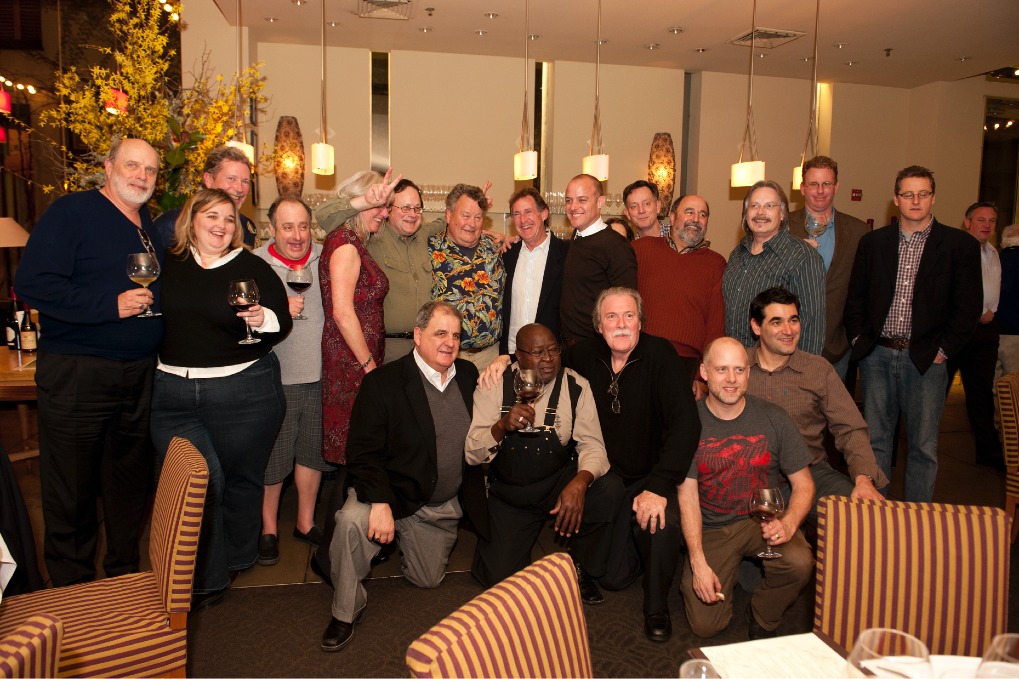 Four of the dinner’s six courses were accompanied by magnums of historic vintages of William Selyem wines from the personal library of Burt. The wines and my brief notes: 1992 Allen Vineyard Chardonnay (inaugural release; mineral, citrus and nutty aromas and flavors that are vibrant and backed by well-honed acidity), 1992 Olivet Lane Pinot Noir (well-preserved aromas of spice, grilled mushrooms and forest floor followed by moderately intense plum and dark berry flavors, ending with a silky, lengthy finish), 1995 Rochioli Vineyard Pinot Noir (wow! Impressive load of intensely-flavored black cherry fruit with hints of leather, mushroom, vanilla and cola along with a creamy, opulent texture and a finish that hangs on with a vengeance) and 1995 Hirsch Vineyard Pinot Noir (highly aromatic with good mixed dark berry fruit intensity backed by a firm tannic spine with plenty of fruit and spice on the finish).
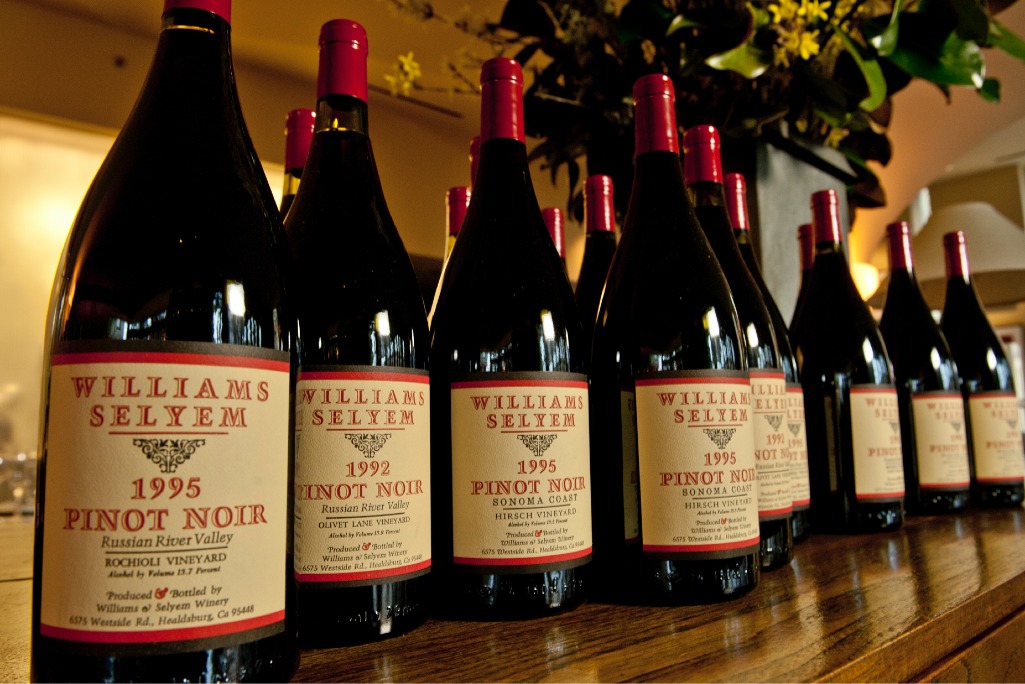 With each wine presented at the dinner, Burt came to the podium and read his production notes on the wine the year it was released. All those in attendance were astonished at the freshness of the wines after 15 to 18 years. The magnum format and the provenance of the wines (they had been stored in Burt’s cellar since release) contributed to their impressive showing. All the details of the dinner are presented at www.princeofpinot.com/article/1071/.
Central Coast Wine Classic Charity Auction Blake Brown, a resident of Santa Barbara, is a true devotee of Williams Selyem Pinot Noir and a close friend of Burt’s. He arranged with Burt to offer many of Burt’s Williams Selyem wines from 1984 to 1997 and a dinner for 10 people at the San Ysidro Ranch at the 2014 Central Coast Wine Classic Charity Auction. The lot raised $15,000. Some of the top wines at the dinner, held December 3, 2014, included 1995 Allen Vineyard Chardonnay in magnum, 1985 and 1991 Rochioli Vineyard Pinot Noir, 1996 Precious Mountain Vineyard Pinot Noir and 1991 Russian River Valley Zinfandel. Blake said afterwards, “This was one of the finest wine experiences I have ever had. The combination of the friends who attended, the ambience, the food, the service, and especially the wines were as good as it gets. To know charities benefited from the pleasures we all shared made the evening all the more special. Burt reviewed each wine including vineyard source, vintage details and so forth. He also shared inside stories of the people involved in each wine. The photo below shows Burt in his signature Hawaiian shirt and his pal Blake at the event.
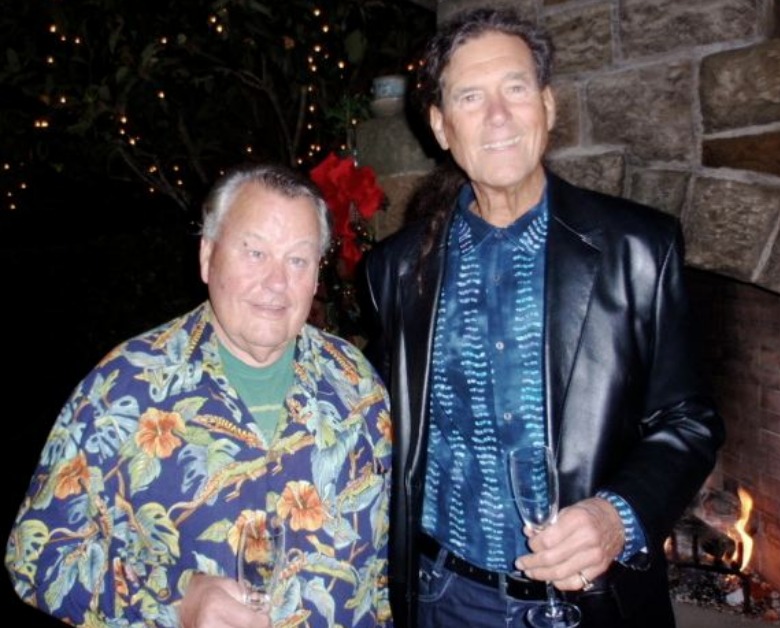
Magnum Tasting in Burgundy For years, Burt was enticed to visit Burgundy but he had a strong dislike of flying and turned down many invitations. Upon the urgings of Raj Paar and Mel Knox (Francois Frères), Burt did go to Burgundy on one occasion in 2016. A tasting was held at the home in Beaune of Becky and Russell Hone and the results were reported by Allen Meadows in the 6/17 issue of the Burghound . His scores were all in the 91-96 range. Allen was an avid collector of Williams Selyem wines beginning in the mid-1980s. In all, 12 magnums of Williams Selyem Pinot Noir were tasted: 1985 Rochioli Vineyard, 1986 Rochioli Vineyard, 1988 Allen Vineyard, 1991 Summa Vineyard, 1991 Allen Vineyard, 1992 Rochioli Vineyard, 1994 Rochioli Vineyard, 1995 Summa Vineyard, and 1996 Precious Mountain Vineyard. Burt supplied the wines and was to comment afterwards that all the wines showed well.
My 2016 Experience with Two Older Vintages I had the opportunity to taste two older vintages of Williams Selyem Pinot Noir that were in pristine condition: 1993 Williams Selyem Cohn Vineyard Russian River Valley Pinot Noir and 1995 Williams Selyem Allen Vineyard Russian River Valley Pinot Noir. Cohn Vineyard, now an estate vineyard of Benovia Winery, entered Burt’s radar through a winemaker friend at Hop Kiln Winery who was sourcing Pinot Noir from Cohn Vineyard beginning in 1981. When the Hop Kiln Winery contract expired in 1987, Burt snatched the grape source. Usually the grapes were blended into the Russian River Valley and Sonoma County bottlings. A vineyard designated Cohn Vineyard Pinot Noir was produced in only 1988 and 1993. Burt dropped the vineyard in 1995 when owner Arne Cohn put in drip irrigation and over-watered the vines. My tasting notes on the 1993 Cohn Vineyard Pinot Noir: The wine had an astonishing freshness and color, with a nose infused with aromas of incense, spice, Bing cherry and rose petal that persisted over an hour while the bottle was consumed with two winemakers. Tasted blind, it would have been impossible to identify this wine as 23-years-old. The balance was impeccable, the oak thoroughly immersed, and the tannins gossamer in nature. It was without a doubt one of the greatest, if not THE greatest old California Pinot Noir I have ever tasted in over 40 years of tasting California Pinot Noir.”
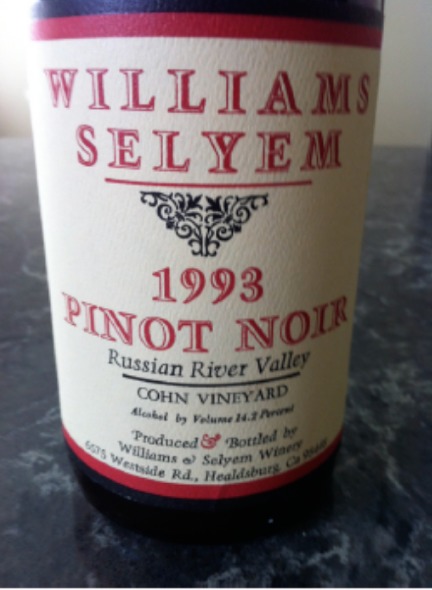 One of the cornerstones sources of Pinot Noir for Williams Selyem was Allen Vineyard. This vineyard stood on its own as a vineyard designate and was consistently one of the favored vineyards in the Williams Selyem vineyard designate program. The 1995 Allen Vineyard Pinot Noir tasting note: Upon opening, aromas of spice, leather, woodland and cherry zoomed from the glass but faded over time. The wine was still fascinating to drink, offering ever-changing nuances of flavor including cherry, strawberry, orange-infused cranberry, orange pekoe tea and brown spices. At 13.7% alcohol, the wine was easy to drink, with resolved tannins and a sappy richness still persisting on a surprisingly long finish. Not epiphanic like the 1993 Cohn bottling, but extremely engaging in its own way.” More examples of aged Williams Selyem Pinot Noirs were reviewed by me in 2014 at www.princeofpinot.com/article/1487/.
Benovia Winery Cohn Estate Vineyard 45th Anniversary Celebration On Sunday, March 11, 2018, fans of Benovia wines (“Benovians”) gathered at Valette Restaurant in Healdsburg for a special luncheon and tasting of multiple vintages of Cohn Estate Vineyard wines. Burt Williams and his second wife, Rebecca, were special guests at this event that I attended. They are pictured below with Benovia Winery owners Joe Anderson and Mary Dewane.
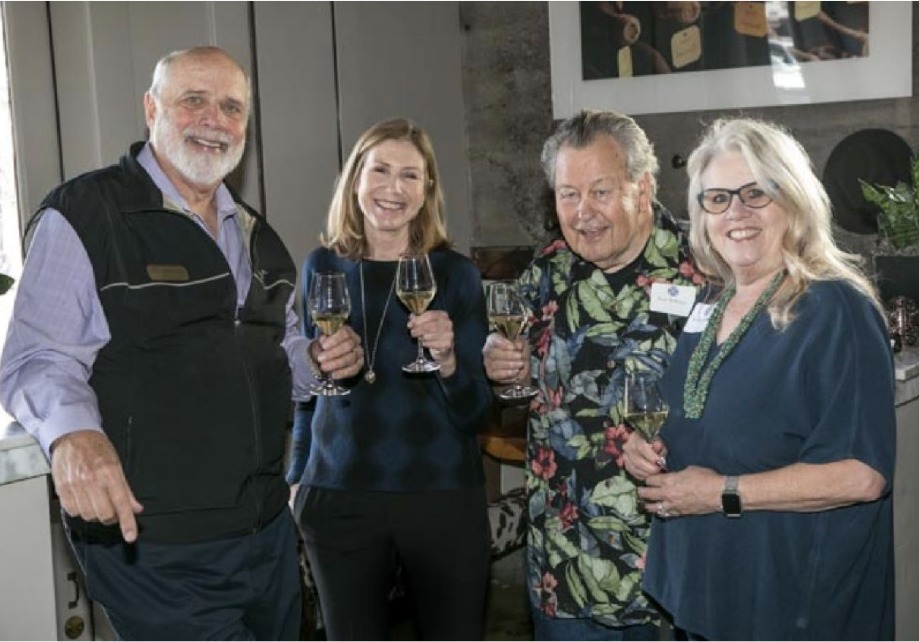 Burt vinified a Williams Selyem Cohn Vineyard Pinot Noir in 1987, 1989 and 1993. He brought a bottle of the 1987 vintage for the luncheon party to taste. The wine still had amazing life spirit after 20 years, showing vibrant notes of tart cherry, strawberry, dried flowers and sandalwood. Burt also brought a magnum of the 1993 Cohn Vineyard Pinot Noir (photo below). This wine was magnificent as well. It was the 1993 Williams Selyem Cohn Vineyard Pinot Noir that was Joe Anderson’s epiphany wine, making him switch from a preference for Cabernet Sauvignon to Pinot Noir and eventually leading him to found Benovia Winery.
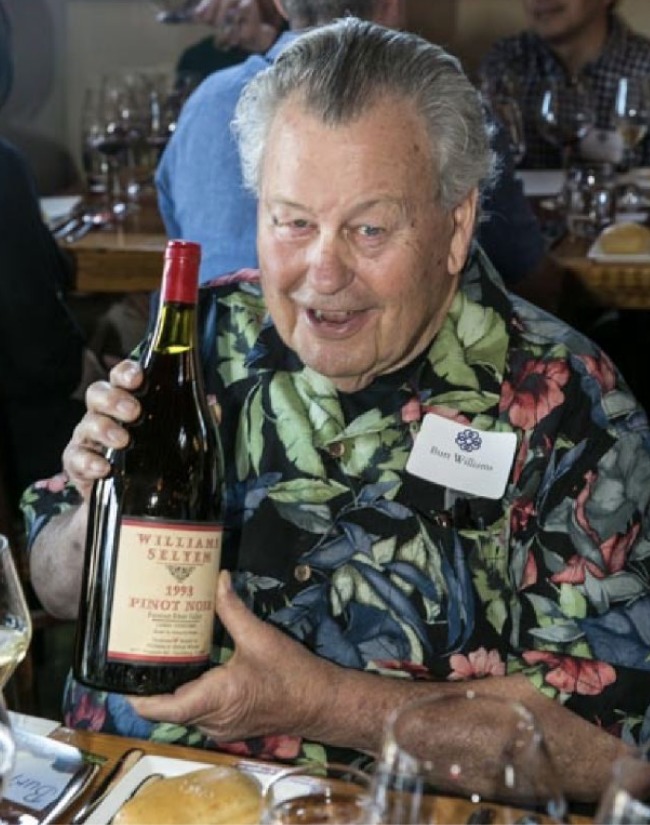
The Winery Takes its Toil, Selling in 1998
Burt Williams
In 1997, Ed decided he wanted to get out of the winery and wanted to sell ࡪ of his share to Burt and financially consult. In order to pay Ed off, Burt realized he would have to keep production at least at the annual 7,000 case level for a few years and this was more wine than he wanted to produce. Burt was working 16 hours a day during the 2-month critical harvest period and the work had become intense and hectic. He knew he could hire help, but he felt he hand to be present and firsthand at all times during the winemaking process. Denise Selyem, Ed’s daughter, had joined the winery in 1995 supporting production by working crush, bottling, labeling and packaging, but the hands-on winemaking work remained up to Burt. An additional consideration was that the Williams Selyem wines were constantly being judged and scored and the partners had to devote time to maintain relationships with many wine writers. Burt finally decided it was better to sell the winery. He reasoned that he could always make wine for himself. The winery was put on the market in 1997 and there were many suitors. Finally, Williams Selyem was sold on March 1, 1998, to New-York based vintner John Dyson for a reported $9.5 million. Dyson, who had been a long-time member of the Williams Selyem mailing list, essentially bought the Williams Selyem name and inventory of the winery, since Burt and Ed never owned a vineyard or a physical winery. The last vintage Burt vinified at Williams Selyem was 1997. The 1997 wines were in barrel at the time of the sale and were finished by the new winemaker, Bob Cabral. The sale included a 5-year winemaking advisory role and a 5-year non-compete thereafter. Although Burt had taken meticulous technical notes regarding vineyard grape samples, weather, picking dates, fermentation temperatures, vinification decisions, aging, and as well as extensive tasting impressions throughout his career, and this proved invaluable to Bob in the ensuing vintages, the relationship between the two never thrived and Burt left Williams Selyem permanently after 1998. This was not surprising as Burt had enjoyed complete control of the winemaking at Williams Selyem, was devoted to the hands-on raising of his wines and found it difficult to transition out. Bob always admired Burt for his accomplishments and said, "Williams Selyem was always about quality, never profit." The last vintage of Williams Selyem Rochioli Vineyard Pinot Noir was 1997 and sold for $125 a bottle at Williams’ request.
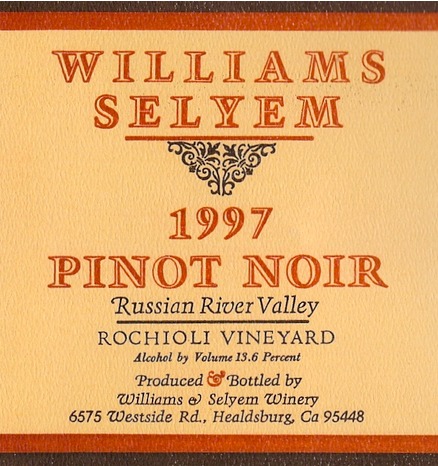 Two of Burt’s three progeny were inspired to become winemakers but they were not in a position to take over the winery. Daughter Margi Williams-Wierenga, who was a teenager when her father began making wine in the 1970s at home, worked as a volunteer at the winery in Fulton before taking a paid position as an assistant to Burt and Ed in 1990 at the Allen Ranch facility. In 1998, when Williams Selyem was sold, she decided to follow in her father’s footsteps and started her own bootstrap winery, Brogan Cellars. Her friendships in the wine community led her to acquire a number of excellent fruit sources for her Chardonnay, Sauvignon Blanc, Pinot Noir and Zinfandel wines. Burt and Margi are shown below at Burt’s Tribute Dinner. Margi closed Brogan Cellars in 2018.
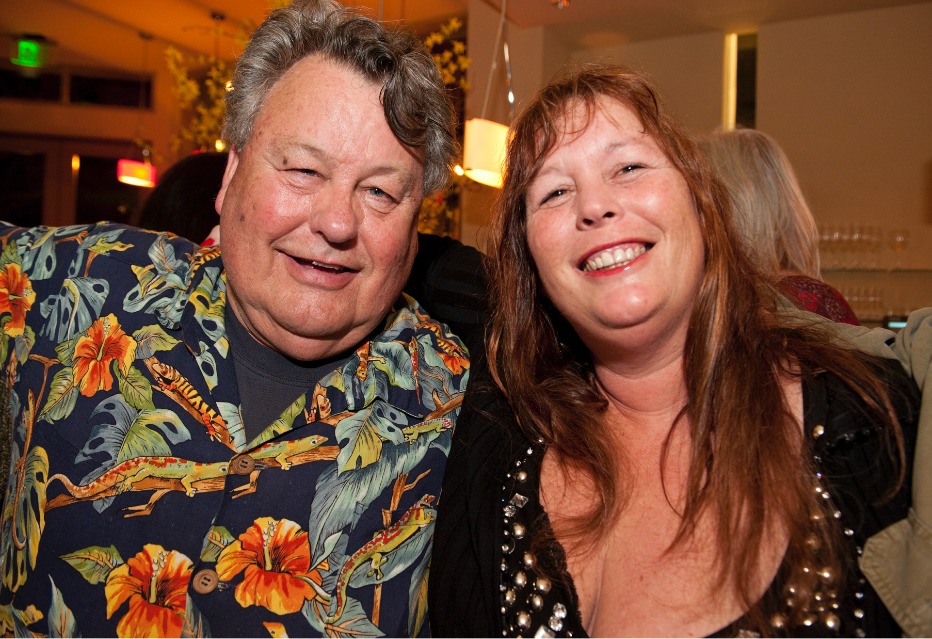 Burt’s son, Fred B. Williams, Jr., also pursued winemaking, worked at Williams Selyem and had his own small label, Seven Lions, specializing in Pinot Noir, Zinfandel and Chardonnay. He crushed grapes for his label in 2002 and 2003 before tragically passing away at the age of 38 from burns suffered in a truck explosion in 2003. Burt’s other daughter, Katie, was involved behind the scenes at Williams Selyem in the business and marketing arm.
Morning Dew Ranch: A New Beginning in the Anderson Valley
Burt Williams
Morning Dew Ranch was located on a 20% sloping, south-facing hillside at 660-850 feet elevation in the “deep end” of the Anderson Valley reached by an old logging road off Highway 128 near Philo. About one-third of the property was cleared of trees for the vineyard but the rest of the property’s established forest was left untouched. A vineyard was planted between 1999 and 2001 by Burt under the direction of vineyardist Steve Williams (no relation) and contained Pommard, Mariafeld (clone 23, a favorite of Burt’s deceased son), Dijon 115, 777 and “828,” a DRC-La Tache selection from Anderson Valley and a Rochioli selection thought to be Pommard 5 clone taken as budwood from the Rochioli Vineyard by Steve Williams. Steve was also the vineyard manager for Ferrington Vineyard in the Anderson Valley and Weir Vineyard in nearby Yorkville Highlands. The soils at Morning Dew Ranch were silty Franciscan clay underlain with sandstone. Vine spacing was 8’ x 6’ with VSP trellising, spur pruned. The vines were irrigated initially until they were established, and only limited irrigation was used thereafter in certain vintages to fully ripen the grapes. Burt built a pond at the bottom of the property during the first year because wells frequently dry up in the Anderson Valley. Winemaker Jason Drew, who sourced grapes from Morning Dew Ranch, remarked, “The vineyard has all the features I look for: great soil structure, hillside drainage, higher elevation, coastal influence, excellent field selections and great care given to the vineyard.
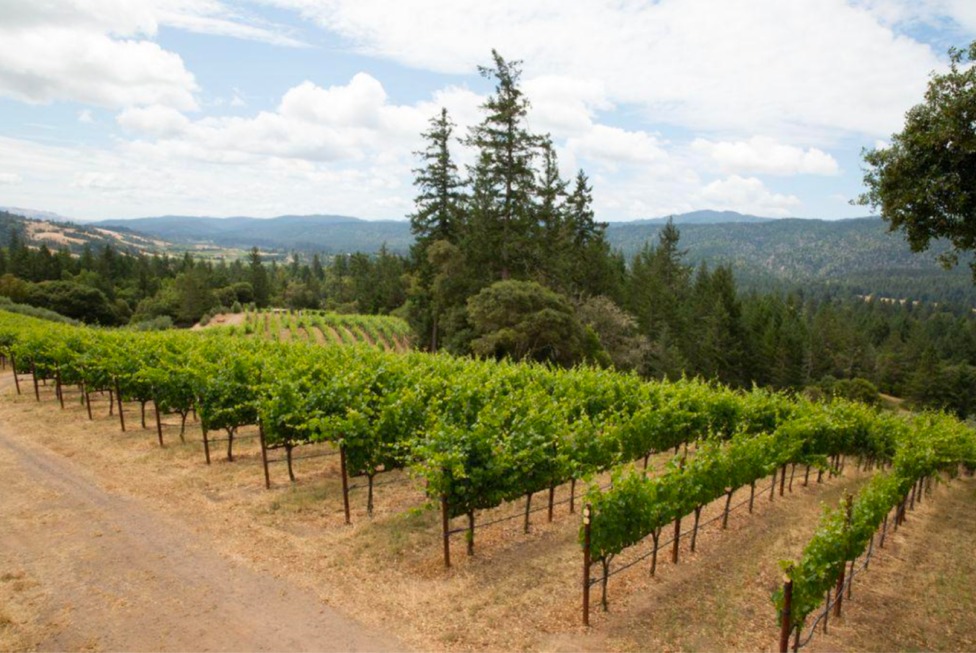 The grapes from Morning Dew Ranch were sold beginning in 2004 and were released as a vineyard-designate Pinot Noir by Brogan Cellars, Woodenhead, Whitcraft, Williams Selyem, Miura and Drew Family Cellars. All grape contracts with these producers were on a handshake basis. The two-story, two-bedroom house on the property was outfitted for winemaking by Burt with a lab and crush pad. Burt’s passion for winemaking was eventually revived and he used equipment he made himself to craft wine here. He made small amounts of Pinot Noir from his vineyard from the 2008 and 2009 vintages, allowable because his 10-year non-compete clause expired in 2008. He released the wines commercially in the late summer of 2011 (197 cases of the 2008 vintage, $60) and the spring of 2012 (228 cases of the 2009 vintage, $75) under the Morning Dew Ranch label. The wines were sold primarily to close friends and long-time customers of Williams Selyem. The 2008 vintage Morning Dew Ranch Pinot Noir had some smoke taint due to Mendocino County fires before harvest in that vintage. The 2009 Morning Dew Ranch Pinot Noir was the last commercial vintage of Pinot Noir that Burt ever crafted. After the winery sale, Burt and his first wife Jan, who passed away in 2011, bought a home in Santa Barbara, a city that he had come to enjoy through many visits in previous years to see winemaker Chris Whitcraft. The home was located in the hills in the Riviera section of the city of Santa Barbara, overlooking the city, the ocean and the Channel Islands. It was a peaceful, vacation-like respite, and Burt would spend 3 to 4 weeks there periodically, dividing his time with his home in Forestville and the one in the Anderson Valley. Starting in the late 1990s, it became an annual tradition to celebrate July 4 at Burt’s Santa Barbara home. A group did not just gather at 9:00 pm to view the fireworks, some started much earlier in the day. Blake Brown attended these Independence Day bacchanals and related one in particular to me that was held on July 4, 2015. “Usually Chris Whitcraft and I would arrive around noon and immediately open up some fabulous Pinots after a quality Champagne that I would provide. Chris would bring some of his gems and Burt would pull out magnums of his and I would bring bottles of Williams Selyem Pinot Noir. We had a whole lot of wine and a whole day to pull some corks.” Burt’s wife, Jan (and later Rebecca), Burt’s two daughters, Margi and Katie, and a few close personal friends would make up the party list. Everyone would bring food and Burt would grill meats and vegetables on his outside Weber. Blake noted, “We ate well but drank just a tad better, Burt was in his element, and we righteously celebrated the 4th.” The wines opened on July 4, 2015: NV Laurent-Perrier Brut Rosé, 1997 Williams Selyem Coastlands Sonoma Coast Pinot Noir, 1997 magnum Williams Selyem Rochioli Vineyard Russian River Valley Pinot Noir (Blake said, “I’ve not found a better Pinot Noir from California or Oregon and think this is the finest Pinot Noir ever produced by Burt although he would argue a few others were as good. I am in Pinot Noir heaven.”) and 2003 magnum Brogan Cellars Russian River Valley Zinfandel. By 2015, Burt was burned out due to the challenges of managing a vineyard, dealing with low yields in some vintages and a significant fire in Anderson Valley in 2008. He simply wanted to take it easy and enjoy retirement. Burt put the Morning Dew Ranch up for sale at an asking price of $1,920,000. The Ranch was sold in 2016 to Castello di Amorosa in Napa Valley. That winery’s first harvest in 2016 was released as a vineyard designate in 2018.
Tasting of Morning Dew Ranch Pinot Noirs
is one of his greatest wines.” Rusty Gaffney
The wines were tasted in flights according to producer so the different styles of winemaking were evident. Nearly all the wines were truly enjoyable, but the 2008 vintage wines suffered from smoke taint and their enjoyment was dependent on the taster’s tolerance for this flaw (or terroir expression if you prefer since the vintage was marked by fires in Mendocino County prior to harvest). The Woodenhead wines were the closest stylistically to Burt’s Williams Selyem Pinot Noirs.
Flight #1
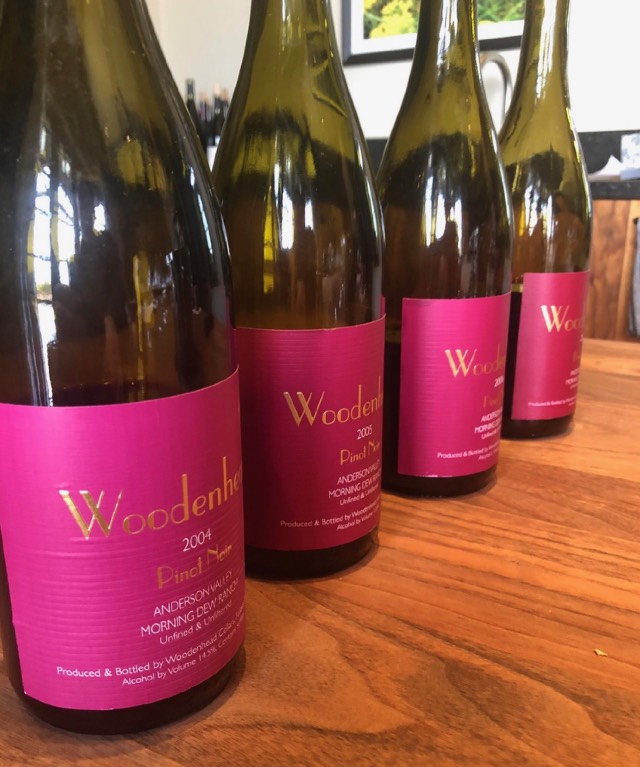
2004 Woodenhead Morning Dew Ranch Anderson Valley Pinot Noir 14.5% alc.. Unfined and unfiltered. 21.4% clone 777, 64.2% Rochioli selection (22% added as whole cluster) and 14.2% clone 23. · Moderately dark garnet color in the glass. Aromas of forest floor and bruised cherry lead to a mid weight plus styled wine offering blackberry and cassis flavors with a hint of oak in the background. Still very much alive, with a juicy finish.
2005 Woodenhead Morning Dew Ranch Anderson Valley Pinot Noir 13.9% alc.. Unfined and unfiltered. 66.6% Rochioli selection and 33.3% clone “828.’ · Moderately dark garnet color in the glass. Enticing aromas of spice, dried leaves and floral bouquet. A full-bodied wine, with a gorgeous core of Bing cherry fruit, gracious tannins, a trace of oak and a long finish with a good cut of acidity. Exceptional.
2006 Woodenhead Morning Dew Ranch Anderson Valley Pinot Noir 13.5% alc.. Unfined and unfiltered. 100% Rochioli selection. · Moderately light garnet color in the glass. Aromas of earthy flora and red cherry. A lighter-weighted wine featuring redder fruits and more spirited acidity.
2007 Woodenhead Morning Dew Ranch Anderson Valley Pinot Noir 14.2% alc.. Unfined and unfiltered. · Moderate garnet color in the glass. Terrific aromatic purity with scents of black cherry, white pepper, tobacco and seasoned oak. Beautifully balanced in a mid weight style featuring a charge of fresh, darker red fruits infused with joyous acidity. A 12-year-old wine that is still remarkably fresh.
No 2008 Woodenhead Morning Dew Ranch Pinot Noir was produced due to the vintage smoke taint.
Flight #2
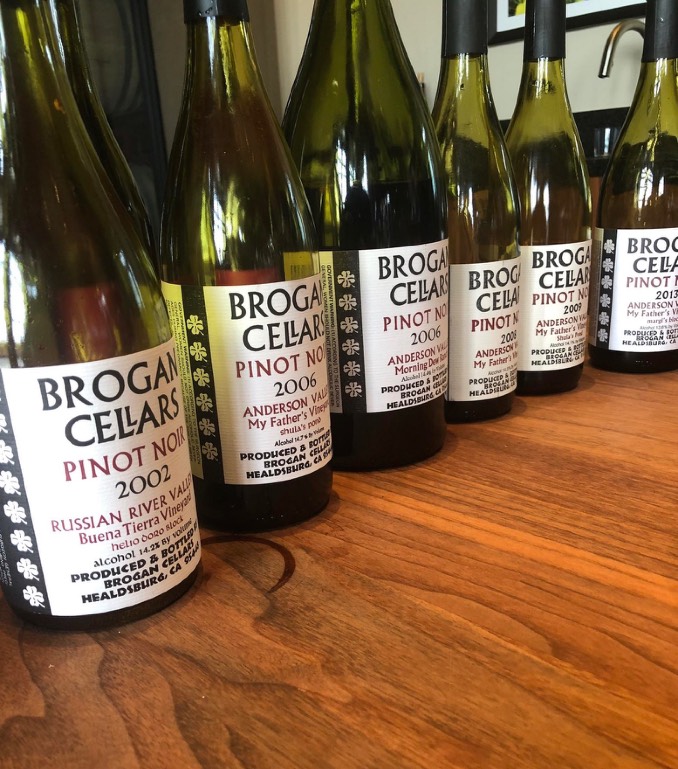
2006 Brogan Cellars Morning Dew Ranch Anderson Valley Pinot Noir 14.4% alc., $90 (magnum). Aged 11 month in 50% new French oak barrels. · Moderate garnet color in the glass. Slightly oxidized, offering aromas of cherry and herbs. Middleweight in style and sleek in texture, with appealing flavors of dark red berry and cherry and pennyroyal. Good supportive acidity.
2006 Brogan Cellars My Father’s Vineyard Shula’s Pond Anderson Valley Pinot Noir 14.7% alc.. · Moderate garnet color in the glass. Slight oxidative nose. Intense flavors of dark red cherry and berry in a mid weight plus style, with modest ripe tannins and a big, sweet cherry finish.
2008 Brogan Cellars My Father’s Vineyard Anderson Valley Pinot Noir 14.5% alc., $50. · Moderate garnet color in the glass. The dark fruited core has faded some and the acidity and tannins peak out. There is definite smoke taint evident on the nose and palate.
2009 Brogan Cellars My Father’s Vineyard Shula’s Pond Anderson Valley Pinot Noir 14.1% alc., $70. “828” block. · Moderately dark garnet color in the glass. Nicely perfumed with black cherry, black raspberry and spice. A comforting wine with fine balance in a mid weight style offering flavors of purple and black fruits and cola framed by modest residual tannins and finishing with purpose. Very enjoyable.
2013 Brogan Cellars My Father’s Vineyard Margi’s Block 13.6% alc.. 100% Rochioli selection. · Moderate garnet color in the glass. A clean, fresh array of dark red berry fruit aromas lead to a lively mid weight style offering a core of fresh Bing cherry and cola fruit with a hint of anise. Nicely composed, with a persistent finish. Excellent.
Flight #3
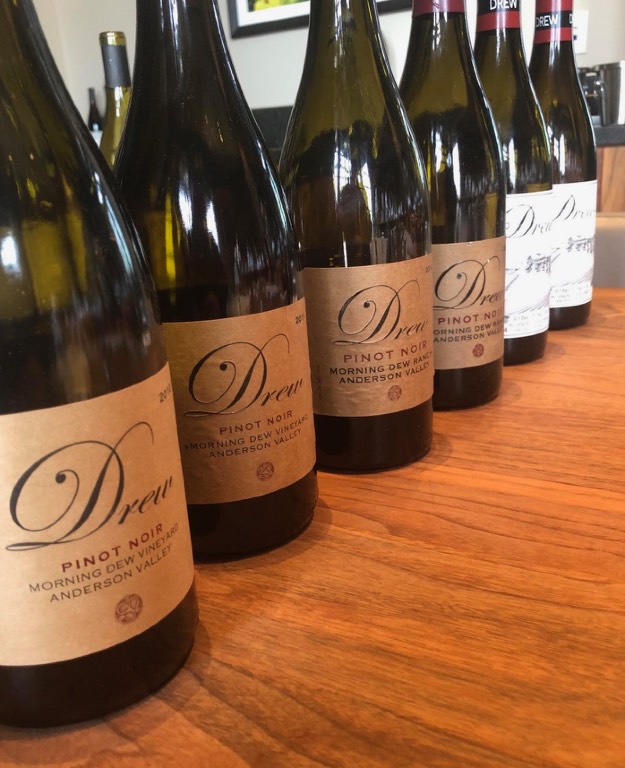
2010 Drew Morning Dew Vineyard Anderson Valley Pinot Noir 13.5% alc., 165 cases, $47. The second release from this vineyard. Rochioli selection and clone “828.” The Rochioli block is planted in lighter soils providing finesse and charm while the “828” block is planted in darker, more clay-imbued soils giving more power and richness. 50% whole cluster. 50% native fermentation. Aged 11 months in 30% new French oak barrels. Bottled unfined and unfiltered. · Moderately light garnet color in the glass. Appealing aromas of cherry, spice and leaf. A cherry-driven wine in a mid weight style with a compliment of spice. Well-balanced with gossamer tannins and some finishing drive. I liked this wine a lot and was impressed by how well it aged.
2011 Drew Morning Dew Ranch Vineyard Anderson Valley Pinot Noir 12.6% alc.. Rochioli selection and clone “828.” · Light garnet color in the glass. Pleasing aromas of red cherry, earthy flora, cinnamon and pennyroyal. Light in weight, with muted red fruit flavors backed by good acidity. A little Brettanomyces in this bottle.
2012 Drew Morning Dew Ranch Anderson Valley Pinot Noir 13.0% alc., $55. Rochioli selection and clone “828.” Hºarvest Brix 22.5º-23.5º. 30% whole cluster. Native fermentation. Aged 11 months in 33% French oak barrels. · Light garnet color in the glass. Fresh aromas of cherry soar from the glass. An elegant wine with a sleek texture, featuring red fruits framed by gentle tannins. Nicely composed and charming.
2013 Drew Morning Dew Ranch Anderson Valley Pinot Noir 13.3% alc., pH 3.61, TA 0.64, 198 cases, $55. Rochioli selection and clone “828.” Harvest Brix 23.0º-23.5º. Yield 1.5 tons per acre. 50% whole cluster. Native primary and malolactic fermentation. Aged 11 months in 25% new French oak barrels. · Moderate garnet color in the glass. Terrific, heady nose displaying hi-tone aromas of cherry and exotic spice. A mid weight plus cherry bomb in a mid weight plus style maintaining balance with ripe tannins and complimentary acidity. Extraordinary.
2014 Drew Morning Dew Ranch Anderson Valley Pinot Noir 13.2% alc., 166 cases, $60. 66% Rochioli selection and 34% clone “828.” Yield 1.7 tons per acre. Native fermentation. Aged 11 months in 30% new French oak barrels. · Moderately light garnet color in the glass. Lovely scent of cherries, spice and rose petal. Elegantly styled with a mid weight core of dark cherry fruit. A little herb and tobacco flavor chimes in. Rather straightforward, but pleasurable.
2015 Drew Morning Dew Ranch Anderson Valley Pinot Noir 13.1% alc., 75 cases, $60. Yields down more than 50% in this vintage to 0.50 tons per acre. Rochioli selection and clone “828.” 50% whole cluster. Native yeast fermentation. Aged 11 months in 33% new Francois Frères French oak barrels. · Moderately dark garnet color in the glass. Deep aromas of cherry and exotic spices. Really good bones in this refined, mid weight plus, young wine still showing some tannin and oak overlying the delicious dark red fruits. Needs time.
Flight #4
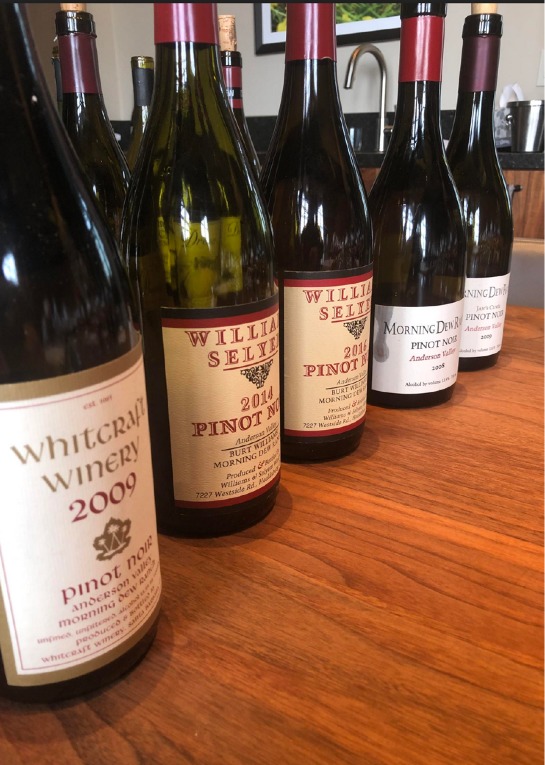
2009 Whitcraft Morning Dew Ranch Anderson Valley Pinot Noir 13.5% alc.. Chris Whitcraft first produced a Pinot Noir from Burt’s vineyard in 2004. Unfined and unfiltered. · Moderately light garnet color in the glass. The nose is very funky replete with hospital bandage aroma. Very ripe fruited, even compotey in a full-bodied style featuring blackberry fruit flavor. Off bottle.
2014 Williams Selyem Burt Williams’ Morning Dew Ranch Anderson Valley Pinot Noir 13.2% alc., $82. Aged 16 months in 67% new French oak barrels. · Moderate garnet color in the glass. Aromas of dusty black cherry, spice and and oak. A mid weight plus styled wine fueled with intense black cherry flavor shadowed by oak. Finishes with some drive and length.
2016 Williams Selyem Burt Williams’ Morning Dew Ranch Anderson Valley Pinot Noir 13.6% alc., $85. Aged 16 months in 57% new and 43% 1-year-old French oak barrels. · Moderate garnet color in the glass. The nose is a bit muted with faint aromas of black cherry and cola. More charming on the palate but does not offer the fruit intensity of the 2014 vintage tasted prior. Rather generic and may be not be an exemplary bottle.
2008 Morning Dew Ranch Anderson Valley Pinot Noir 13.8% alc., 197 cases, $60. A selection of three blocks, each a different clone. 25% whole cluster. Fermentation in open-top, stainless steel tanks for 12 days. Gravity racked and pressed to 100% new Francois Frères oak barrels. Aged 15 months on the gross lees before being racked to a tank for bottling. The wine was never pumped, fined or filtered. Burt’s notes: “The vintage and terroir are both present in this wine as they have been in all my wines. There is initially a smoky aroma that combines a dark berry fruit component with hints of roasted nuts and earth, medium-rich palate, ripe tannins and berries on the finish. My suggestion is to decant the wine to allow the smoky components to recede a bit and allow the fruit to come forward showing berry and pie cherry complexities. · Moderate garnet color in the glass. Aromas of sweet pipe smoke, barbecue and black cherries. Clearly smoke tainted in a mid weight plus style featuring dark cherry and berry fruits, finishing with mild astringency.
2009 Morning Dew Ranch Jan’s Cuvée Anderson Valley Pinot Noir 13.6% alc., 228 cases, $75. Burt used grapes that were left over after others had picked and includes Rochioli selection and DRC selection. The winemaking regimen was the same as for the 2008 vintage. Burt is a modest soul, but calls this “A wine apart.” I have tasted this wine now four times including this November tasting. · Moderately dark garnet color in the glass. Alluring aromas of pie cherries, spice, and white pepper. Tantalizing flavors of brandied black cherries, black raspberries, anise and spice in a mid weight plus style. Lovely, with impeccable balance and an incredibly long finish. A majestic wine and one of Burt’s best achievements.
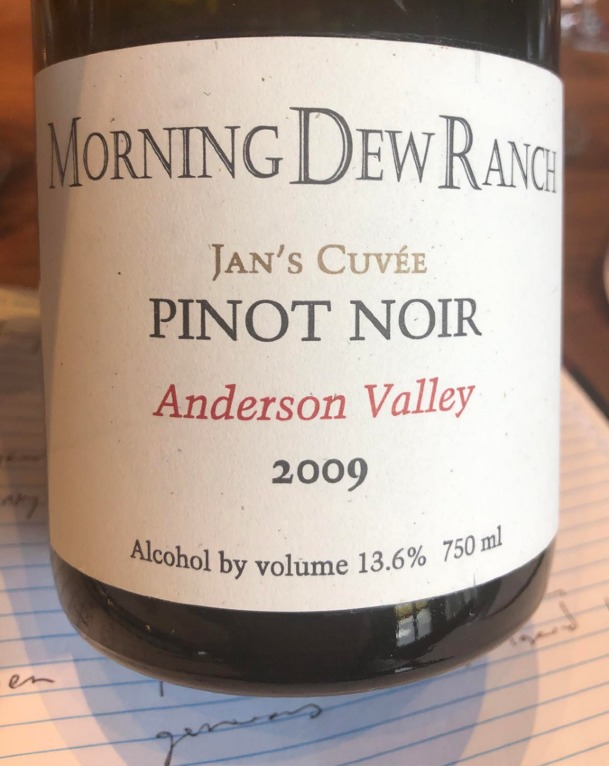 The following wine was not included in the November tasting but was tasted by me at home. I have included it so that every winery that sourced Morning Dew Ranch grapes is part of this tasting report. Miura Vineyards, located in Santa Rosa, is owned by Emmanuel Kemjii and the wine is crafted by Byron Kosuge. This winery produced a Morning Dew Ranch Pinot Noir in 2011 (2 cases), 2012 (184 cases), 2013 (133 cases), 2014 (147 cases) and 2015 (38 cases).
2015 Miura Morning Dew Ranch Anderson Valley Pinot Noir 13.0% alc., 38 cases, $75. Yields reduced by 65%. · Moderately dark garnet color in the glass. Pleasing aromas of dark berries, rose petal and sweet oak. Sleek and polished in the mouth, with vibrant flavors of black cherry, blackberry and dark chocolate with a compliment of oak in the background. Plenty of fruit substance, but not overblown, with gentle fine-grain tannins, and a demonstrative, juicy finish. Excellent.
Burt’s Legacy was Far-reaching
Burt Williams
Burt’s career will show that winemaking, like any craft, is a God-given talent, enhanced by education and experience. Still, it is a craft for which some people are more blessed than others. Beyond Burt’s winemaking achievements that reflect his incredible intuition for crafting Pinot Noir, he influenced a long list of other winemakers as well as growers. Here I name just a few including Steve Doerner (Cristom Vineyards; Burt’s first choice to replace him when Williams Selyem was sold), Manfred Krankl (Sine Qua Non), Tim Olson (Olson Ogden), Tom Dehlinger (Dehlinger Winery), Tom Rochioli (J. Rochioli Vineyards & Winery), Ted Lemon (Littorai), Thomas Rivers Brown (Rivers-Marie) George Levkoff (George Wines), Bob Cabral (former Williams Selyem winemaker, now at Three Sticks), Denise Selyem and Kirk Hubbard (WesMar Winery), Michael Sullivan (Benovia Winery), Bob Pelligrini (Pellegrini Wines and Olivet Lane Vineyard), Edward McDonald (Vision Cellars), Ross Cobb (COBB Wines), Nikolai Stez (Woodenhead Cellars) and Christ Whitcraft (Whitcraft Winery). There are undoubtedly hundreds of other winemakers who have learned from Burt and have revered him, although they may have never met him. Others who I have quotes from include:
Ben Papaprietro, Papaprietro Perry: “He was my mentor and showed me the way for California Pinot Noir before California new what Pinot Noir could do or knew what was possible.” Jeff Fink, Tantara Winery, Aether Wine Company: “He told me to have a good time making wine, otherwise I was in the wrong profession. He showed the rest of us what was possible.” David Hirsch, Hirsch Vineyard & Winery: “His vineyard work was under-appreciated. He set the stage for workers and growers to work together. He showed the value of specific sites. He picked up American Pinot Noir by the bootstraps and raised it up. When I visited his winery in the winery of 1994, he greeted me, ‘You’ve been to hi-tech, welcome to no-tech!’” Michael Browne, Kosta-Browne and Cirq: “The 1991 Williams Selyem Allen Vineyard Pinot Noir was a badass wine. It blew my head off and was a life-altering experience. I wanted to make wine that good.” Greg Brewer, Brewer-Clifton: "The Williams Selyem partnership model inspired me when we started Brewer-Clifton with $12,000. We followed the model in every detail.” Ted Lemon, Littorai: "Williams Selyem's Summa and Rochioli Pinot Noir, those wines stood up. they were a personal inspiration for me."
At the Burt Williams Tribute Dinner in 2011, Charlie Palmer, chef and owner of Dry Creek Kitchen, said, “When we opened Aureole Restaurant in New York City 23 years ago, we were probably the first restaurant in the City to offer Williams Selyem Pinot Noir on a wine list. We were really impressed with the wines after tasting them. The problem was, none of our customers could pronounce the name. We figured that if we couldn’t sell it, we would just drink it all ourselves.” Noted wine writer, Jay McInerney, penned an article for The Wall Street Journal that was published November 30, 2012, and titled, “How Burt Williams Became Pinot’s Patron Saint.” It was noted in the article that sommelier Daniel Johnnes said that Burt was “the alter ego of Henri Jayer.” McInerney said, “Mr Johnnes is the dean of American Burgundy lovers, and for him to compare Mr Williams, a former printer from California, to the most revered winemaker in the Burgundian pantheon was high praise indeed.” He went on to kiddingly remark, “As far as I know, no one ever saw Henri Jayer wearing suspenders over colorful Hawaiian shirts, as Burt has been known to do.” It was Burt’s many engaging personal qualities that appealed to those in the wine profession as well. Burt’s good friend, Blake Brown, shared a lot of wine together, mostly Burt’s. Blake said, “He had an encyclopedic memory for all of the details of each and every harvest and was so willing to talk about every aspect of that at any moment’s notice. He gladly shared information that many winemakers would consider privileged. Some of our wine-speak sessions would last a good part of the day.” Blake related that as knowledgeable as Burt was about all things wine, he had an equal amount of in-depth knowledge about other topics such as mushrooms (he was an avid hunter with private sources for the kind he preferred), barbecuing, cooking and seasoning. He was adept at skillfully crafting items of usefulness that filled a particular need in lieu of buying a commercial version. Blake also likes to point out that Burt was not all that much interested in boasting or being honored for his achievements. It was rare for him to attend wine events and auctions. I, like Blake, admired Burt’s winemaking passion and acumen, but it was his personality that was uniquely appealing to both of us. Any conversation with Burt was peppered with his hearty laugh that seemed to rise from his belly and finish with a broad smile and a twinkle in his eye. He was kind, humble and friendly as well as a loving family man. I believe the real test of Burt's integrity is I never read or heard anything bad said about him.
Here are the important legacies of Burt Williams, his partner Ed Selyem and Williams Selyem Winery. 1. One of California’s ultimate cult wineries and a first for Pinot Noir. 2. California’s first $100 Pinot Noir. 3. First California Pinot Noir to be exported to Burgundy and offered on restaurant lists in Burgundy. 4. One of the first California wineries to bring consumer’s attention to a sense of place reflected by specific vineyards such as Rochioli, Allen, Olivet Lane, Hirsch, Precious Mountain, Summa and Ferrington. 5. First vineyard-designated Pinot Noirs from Allen Vineyard, Summa Vineyard, Precious Mountain Vineyard, Cohn Vineyard and Olivet Lane Vineyard. 6. Opinioned that a vineyard-designated Pinot Noir should only be offered when the vineyard warranted it. 7. Turned the consumer’s attention to growers and their vital importance in fine wine production. 8. Set the stage for vintners and growers to work together. 9. Fostered the winemaking approach now widely followed by all domestic Pinot Noir producers including cold maceration, hand-sorting of grapes, punch downs, and no pumping in the winery. 10. Brought to the consumer’s attention the importance of choosing carefully the type of French oak to be used for aging Pinot Noir. 11. Developed a proprietary yeast that is now in wide use in Pinot Noir winemaking. 12. Brought worldwide recognition to the Russian River Valley and its wines, particularly Pinot Noir. 13. Bottled wines in magnum format for releases beginning in 1985, an uncommon practice among early Pinot Noir producers, and kept back a library of wines. 14. Employed a mailing list model for selling and allocating wine directly to consumers. The first California Pinot Noir producer to have a waiting list of consumers striving to join the mailing list. 15. Demonstrated that intuition through experience is invaluable in crafting Pinot Noir. 16. Provided willing mentorship for others interested in winemaking. 17. Most importantly, Williams Selyem showed that great wine, and in particular Pinot Noir, can be produced without artifice. Intrusive winemaking methods such as saignée, alcohol adjustment, and the addition of color extracts or enzymes are simply not required nor desired. Technology and expensive equipment can be useful winemaking adjuncts but are not requirements for fine wine production. Burt died on December 11, 2019, at age 79 years from complications of Parkinson’s Disease. He is survived by his second wife Rebecca, two daughters, four grandchildren and three great-grandchildren.
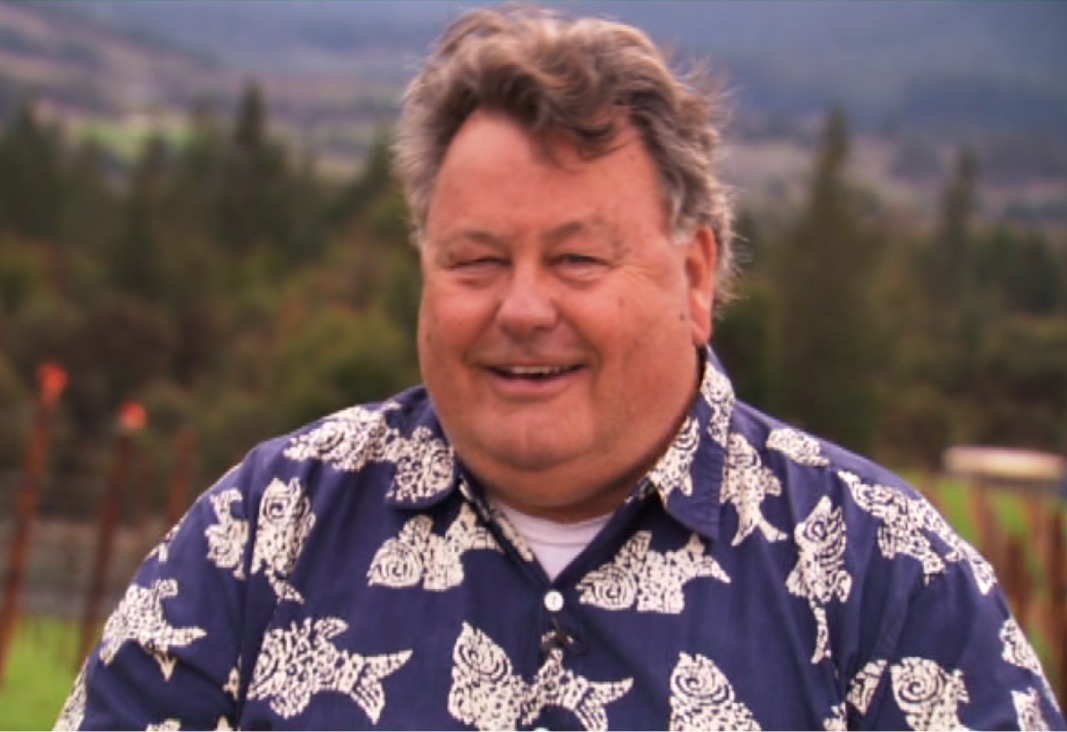
Addendum
Twas the night before harvest
The clusters were hung
When out from the fields
The sirens were blaring
The smudge pots were fired
“On Summa, on Olivet,
The battle was fought
The harvest was perfect
When wines were all bundled
All panic subsided
Allocation Discussion
“We’ll wait until morning
|